Yokogawa SC202 User Manual

User’s
Manual
Model SC202G [Style: S3], SC202S [Style: S3]
2-wire Conductivity or Resistivity Transmitter
IM 12D08B02-01E
IM 12D08B02-01E
8th Edition
TABLE OF CONTENTS |
|
PREFACE |
|
1. Introduction And General Description ............................................................. |
1-1 |
1-1. Instrument check ............................................................................................ |
1-1 |
1-2. Application ...................................................................................................... |
1-3 |
2. general Specifications ....................................................................................... |
2-1 |
2-1. Specifications.................................................................................................. |
2-1 |
2-2. Operating specifications ................................................................................. |
2-2 |
2-3. Model and suffix codes ................................................................................... |
2-5 |
2-4. Control Drawing SC202S mA HART® Specification (IECEx) ......................... |
2-6 |
2-6. Control Drawing SC202S mA HART® Specification ............................................ |
2-8 |
(FM Intrinsically safe design). .......................................................................... |
|
2-8. Control Drawing of SC202S mA HART® Specification (CSA)...................... |
2-10 |
2-9. Control Drawing of SC202S FF/PB Specification (IECEx) ............................ |
2-11 |
2-10. Control Drawing of SC202S FF/PB Specification (ATEX) .......................... |
2-12 |
2-11. Control Drawing of SC202S FF/PB Specification .............................................. |
2-13 |
(FM Intrinsically safe Entity)........................................................................... |
|
2-12. Control Drawing of SC202S FF/PB Specification .............................................. |
2-15 |
(FM Intrinsically safe FISCO)......................................................................... |
|
2-13. Control Drawing of SC202S FF/PB Specification .............................................. |
2-17 |
(FM Non-incendive Entity) ............................................................................. |
|
2-14. Control Drawing of SC202S FF/PB Specification .............................................. |
2-18 |
(FM Non-incendive FNICO) ........................................................................... |
|
2-15. Control Drawing of SC202S FF/PB Specification (CSA) ............................ |
2-19 |
3. Installation And Wiring....................................................................................... |
3-1 |
3-1. Installation and dimensions ............................................................................ |
3-1 |
3-1-1. Installation site................................................................................................................. |
3-1 |
3-1-2. Mounting methods ........................................................................................................... |
3-1 |
3-2. Preparation ..................................................................................................... |
3-3 |
3-2-1. Cables, terminals and glands .......................................................................................... |
3-3 |
3-3. Wiring of sensors ............................................................................................ |
3-4 |
3-3-1. General precautions ........................................................................................................ |
3-4 |
3-3-2. Additional precautions for installations in hazardous areas - Intrinsic safe .................... |
3-4 |
3-3-3. Installation in: Hazardous Area-Non-Incendive .............................................................. |
3-5 |
3-4. Wiring of power supply ................................................................................... |
3-5 |
3-4-1. General precautions ........................................................................................................ |
3-5 |
3-4-2. Connection of the power supply ...................................................................................... |
3-5 |
3-4-3. Switching the instrument on ............................................................................................ |
3-5 |
3-5. Sensor wiring .................................................................................................. |
3-6 |
3-6. Other sensor systems..................................................................................... |
3-7 |
3-6-1. Sensor cable connections using junction box (BA10) and extension cable (WF10)....... |
3-7 |
IM 12D08B02-01E
8th Edition: Oct. 2009(YK)
All Rights Reserved, Copyright © 2001, Yokogawa Electric Corporation
IM 12D08B02-01E
4. Operation; Display Functions And Setting ...................................................... |
4-1 |
|
4-1. Operator interface........................................................................................... |
4-1 |
|
4-2. |
Explanation of operating keys......................................................................... |
4-2 |
4-3. |
Setting passcodes .......................................................................................... |
4-3 |
4-3-1. Passcode protection ........................................................................................................ |
4-3 |
|
4-4. |
Display examples............................................................................................ |
4-3 |
4-5. |
Display functions............................................................................................. |
4-4 |
5. Parameter setting ............................................................................................... |
5-1 |
5-1. Maintenance mode ......................................................................................... |
5-1 |
5-1-1. Introduction ...................................................................................................................... |
5-1 |
5-1-2. Manual activation of Hold ................................................................................................ |
5-1 |
5-2. Commissioning mode ..................................................................................... |
5-2 |
5-2-1. Introduction ...................................................................................................................... |
5-2 |
5-2-2. Range .............................................................................................................................. |
5-3 |
5-2-3. HOLD .............................................................................................................................. |
5-4 |
5-2-4. Temperature compensation............................................................................................. |
5-5 |
5-2-5. Temperature compensation selection ............................................................................. |
5-6 |
5-2-6. Service code.................................................................................................................... |
5-7 |
5-3.Service Codes ................................................................................................. |
5-8 |
5-3-1. Parameter specific functions ........................................................................................... |
5-8 |
5-3-2. Temperature measuring functions................................................................................. |
5-10 |
5-4. Temperature compensation functions........................................................... |
5-12 |
5-5. mA output functions ...................................................................................... |
5-14 |
5-6. User interface ............................................................................................... |
5-16 |
5-7. Communication setup ................................................................................... |
5-18 |
5-8. General ..................................................................................................... |
5-18 |
5-9. Test and setup mode ................................................................................... |
5-18 |
6. Calibration ....................................................................................................... |
6-1 |
|
6-1 When is calibration necessary? ....................................................................... |
6-1 |
|
6-2. |
Calibration procedure ..................................................................................... |
6-2 |
6-3. |
Calibration with HOLD active.......................................................................... |
6-3 |
7. Maintenance ....................................................................................................... |
7-1 |
|
7-1. |
Periodic maintenance for the EXA 202 transmitter......................................... |
7-1 |
7-2. |
Periodic maintenance of the sensor ............................................................... |
7-1 |
8. Troubleshooting ................................................................................................. |
8-1 |
|
8-1. |
Diagnostics ..................................................................................................... |
8-1 |
8-1-1. Off-line checks................................................................................................................. |
8-1 |
|
8-1-2. On-line checks................................................................................................................. |
8-1 |
|
9. USP WATER PURITY MONITORING .................................................................. |
9-1 |
|
9-1.What is USP ? ................................................................................................ |
9-1 |
|
9-2.What is conductivity measurement according to USP? ................................... |
9-1 |
|
9-3.USP in the SC202............................................................................................ |
9-1 |
|
9-4.Setting up SC202 for USP ............................................................................... |
9-2 |
|
10. SPARE PARTS ................................................................................................ |
10-1 |
|
IM 12D08B02-01E

11. Appendix 1 ........................................................................................................ |
1-1 |
||
11-1. User setting for non-linear output table (code 31and 35).............................. |
1-1 |
||
11-2. User entered matrix data (code 23 to 28)...................................................... |
1-1 |
||
11-3. Matrix data table (user selectable in code 22)............................................... |
1-2 |
||
11-4. Sensor Selection........................................................................................... |
1-3 |
||
11-4-1. |
General........................................................................................................................... |
1-3 |
|
11-4-2. |
Sensor selection............................................................................................................. |
1-3 |
|
11-4-3. |
Selecting a temperature sensor..................................................................................... |
1-3 |
|
11-5. |
Setup for other functions............................................................................... |
1-3 |
|
11-6. |
User setting table........................................................................................... |
1-4 |
|
11-7. |
Error codes.................................................................................................... |
1-6 |
|
11-8. |
Device Description (DD) menu structure....................................................... |
1-7 |
|
12. APPENDIX 2....................................................................................................... |
2-1 |
||
12-1. |
Preface ........................................................................................................ |
2-1 |
|
12-2. |
Wiring diagrams............................................................................................ |
2-2 |
|
1. Example of Non-Explosionproof System ............................................................................... |
2-2 |
||
2. Example of Intrinsically Safe Explosionproof System ........................................................... |
2-2 |
||
12-3. |
Sensor wiring................................................................................................. |
2-4 |
|
12-4. |
Supplement of parameter setting.................................................................. |
2-5 |
|
12-4-1. Set cell constant (service code 03)................................................................................ |
2-5 |
||
12-4-2. Temperature sensor (service code 10).......................................................................... |
2-5 |
||
12-4-3. |
Automatic return (service code 50)................................................................................ |
2-5 |
|
12-4-4. |
Error setting (service code 53)....................................................................................... |
2-6 |
|
12-4-5. |
E5 and E6 setting (service code 54).............................................................................. |
2-6 |
|
12-4-6. |
Communication with PH201G (style B) distributor (service code 60)............................ |
2-6 |
|
13. Appendix 3 QUALITY INSPECTION................................................................. |
3-1 |
|
13-1. |
SC202G 2-Wire Conductivity Transmitter..................................................... |
3-1 |
13-2. |
SC202S 2-Wire Conductivity Transmitter...................................................... |
3-5 |
13-3. |
SC202G, SC202S 2-Wire Conductivity Transmitter ........................................... |
3-9 |
(Fieldbus Communication)................................................................................ |
||
13-4. |
SC202G, SC202S 2-Wire Conductivity Transmitter ........................................... |
3-13 |
(Profibus Communication).............................................................................. |
||
Customer Maintenance Parts List SC202G (Style : S3)......... |
CMPL 12D08B02-03E |
|
Customer Maintenance Parts List SC202S (Style : S3)......... |
CMPL 12D08B02-23E |
|
Revision Record........................................................................................................... |
i |
|
In this manual a mAsign appears if it concerns the SC202G -A and SC202S-A, -N, -K.
IM 12D08B02-01E
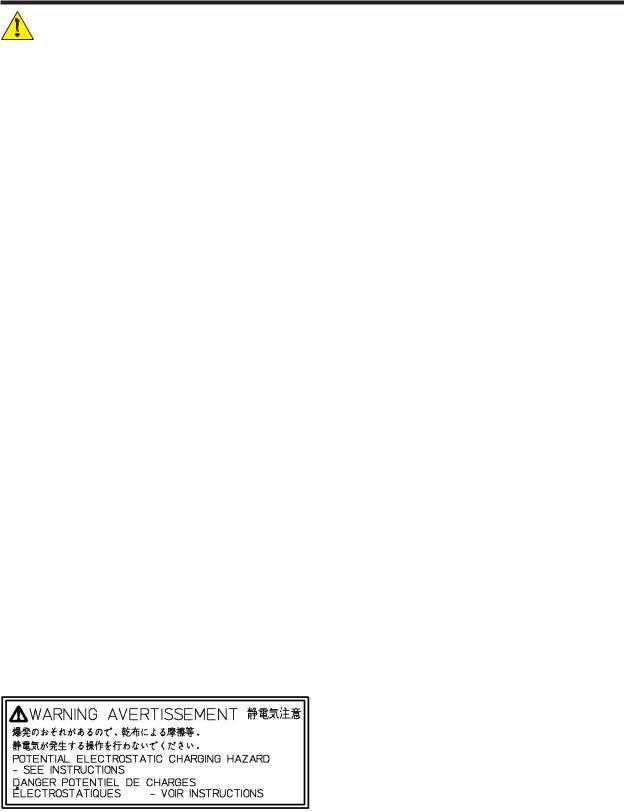
PREFACE
DANGER
Electric discharge
The EXA analyzer contains devices that can be damaged by electrostatic discharge. When servicing this equipment, please observe proper procedures to prevent such damage. Replacement components should be shipped in conductive packaging. Repair work should be done at grounded workstations using grounded soldering irons and wrist straps to avoid electrostatic discharge.
Installation and wiring
The EXA analyzer should only be used with equipment that meets the relevant international and regional standards. Yokogawa accepts no responsibility for the misuse of this unit.
 CAUTION
CAUTION
The instrument is packed carefully with shock absorbing materials, nevertheless, the instrument may be damaged or broken if subjected to strong shock, such as if the instrument is dropped. Handle with care.
Although the instrument has a weatherproof construction, the transmitter can be harmed if it becomes submerged in water or becomes excessively wet.
Do not use an abrasive material or solvent when cleaning the instrument.
Do not modify the SC202 transmitter.
 WARNING
WARNING
Electrostatic charge may cause an explosion hazard. Avoid any actions that cause the generation of electrostatic charge, e.g., rubbing with a dry cloth.
Warning label
Because the enclosure of the Dissolved Oxygen transmitter Type SC202S-A, -P, -F are made of aluminium, if it is mounted in an area where the use of category 1 G Zone 0 apparatus is required, it must be installed such, that, even in the event of rare incidents, ignition sources due to impact and friction sparks are excluded.
Notice
•This manual should be passed on to the end user.
•The contents of this manual are subject to change without prior notice.
•The contents of this manual shall not be reproduced or copied, in part or in whole, without permission.
•This manual explains the functions contained in this product, but does not warrant that they are suitable the particular purpose of the user.
•Every effort has been made to ensure accuracy in the preparation of this manual.
However, when you realize mistaken expressions or omissions, please contact the nearest Yokogawa Electric representative or sales office.
•This manual does not cover the special specifications. This manual may be left unchanged on any change of specification, construction
or parts when the change does not affect the functions or performance of the product.
•If the product is not used in a manner specified in this manual, the safety of this product may be impaired.
Yokogawa is not responsible for damage to the instrument, poor performance of the instrument or losses resulting from such, if the problems are caused by:
•Improper operation by the user.
•Use of the instrument in improper applications
•Use of the instrument in an improper environment or improper utility program
•Repair or modification of the related instrument by an engineer not authorized by Yokogawa.
Safety and Modification Precautions
•Follow the safety precautions in this manual when using the product to ensure protection and safety of the human body, the product and the system containing the product.
IM 12D08B02-01E

The following safety symbols are used on the product as well as in this manual.
DANGER
This symbol indicates that an operator must follow the instructions laid out in this manual in order to avoid the risks, for the human body, of injury, electric shock, or fatalities. The manual describes what special care the operator must take to avoid such risks.
 WARNING
WARNING
This symbol indicates that the operator must refer to the instructions in this manual in order to prevent the instrument (hardware) or software from being damaged, or a system failure from occurring.
 CAUTION
CAUTION
This symbol gives information essential for understanding the operations and functions.
This symbol indicates Protective Ground Terminal
This symbol indicates Function Ground Terminal (Do not use this terminal as the protective ground terminal.)
This symbol indicates Alternating current.
This symbol indicates Direct current.
Warranty and service
Yokogawa products and parts are guaranteed free from defects in workmanship and material under normal use and service for a period of (typically) 12 months from the date of shipment from the manufacturer. Individual sales organizations can deviate from the typical warranty period, and the conditions of sale
relating to the original purchase order should be consulted. Damage caused by wear and tear, inadequate maintenance, corrosion, or by the effects of chemical processes are excluded from this warranty coverage.
In the event of warranty claim, the defective goods should be sent (freight paid) to the service department of the relevant sales organization for repair or replacement (at Yokogawa discretion). The following information must be included in the letter accompanying the returned goods:
•Part number, model code and serial number
•Original purchase order and date
•Length of time in service and a description of the process
•Description of the fault, and the circumstances of failure
•Process/environmental conditions that may be related to the installation failure of the device
•A statement whether warranty or non-warranty service is requested
•Complete shipping and billing instructions for return of material, plus the name and phone number of a contact person who can be reached for further information.
Returned goods that have been in contact with process fluids must be decontaminated/disinfected before shipment. Goods should carry a certificate to this effect, for the health and safety of our
employees. Material safety data sheets should also be included for all components of the processes to which the equipment has been exposed.
IM 12D08B02-01E
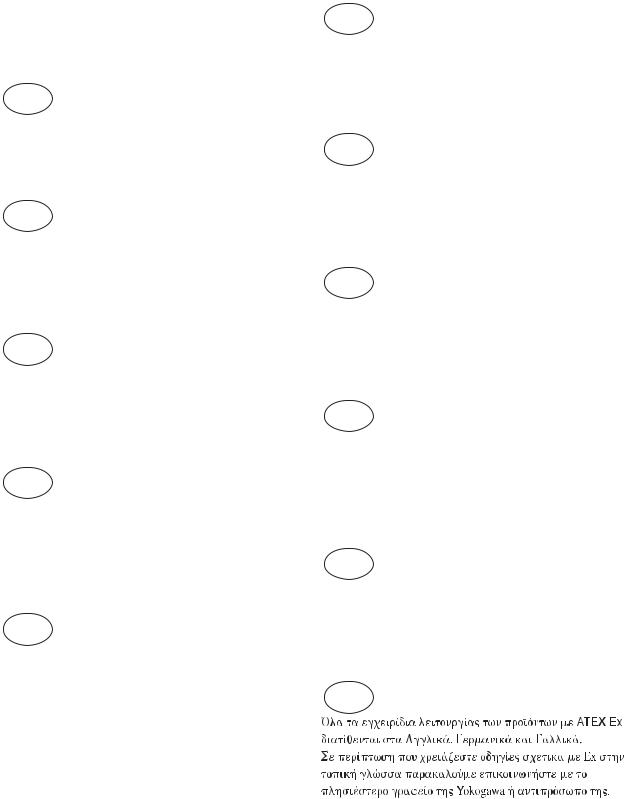
ATEX Documentation
This procedure is only applicable to the countries in European Union.
GB
All instruction manuals for ATEX Ex related products are available in English, German and French. Should you require Ex related instructions in your local language, you are to contact your nearest Yokogawa office or representative.
DK
Alle brugervejledninger for produkter relateret til ATEX Ex er tilgængelige på engelsk, tysk og fransk. Skulle De ønske yderligere oplysninger
om håndtering af Ex produkter på eget sprog, kan De rette henvendelse herom til den nærmeste Yokogawa afdeling eller forhandler.
I
Tutti i manuali operativi di prodotti ATEX contrassegnati con Ex sono disponibili in inglese, tedesco e francese. Se si desidera ricevere i manuali operativi di prodotti Ex in lingua locale, mettersi in contatto con l’ufficio Yokogawa più vicino o con un rappresentante.
E
Todos los manuales de instrucciones para los productos antiexplosivos de ATEX están disponibles en inglés, alemán y francés. Si desea solicitar las instrucciones de estos artículos antiexplosivos en su idioma local, deberá ponerse en contacto con la oficina o el representante de Yokogawa más cercano.
NL
Alle handleidingen voor producten die te maken hebben met ATEX explosiebeveiliging (Ex)
zijn verkrijgbaar in het Engels, Duits en Frans. Neem, indien u aanwijzingen op het gebied van explosiebeveiliging nodig hebt in uw eigen taal, contact op met de dichtstbijzijnde vestiging van Yokogawa of met een vertegenwoordiger.
SF
Kaikkien ATEX Ex -tyyppisten tuotteiden käyttöhjeet ovat saatavilla englannin-, saksanja ranskankielisinä. Mikäli tarvitsette Ex -tyyppisten tuotteiden ohjeita omalla paikallisella kielellännne, ottakaa yhteyttä lähimpään Yokogawa-toimistoon tai -edustajaan.
P
Todos os manuais de instruções referentes aos produtos Ex da ATEX estão disponíveis em Inglês, Alemão e Francês. Se necessitar de instruções na sua língua relacionadas com produtos Ex, deverá entrar em contacto com a delegação mais próxima ou com um representante da Yokogawa.
F
Tous les manuels d’instruction des produits ATEX Ex sont disponibles en langue anglaise, allemande et française. Si vous nécessitez des instructions relatives aux produits Ex dans votre langue, veuillez bien contacter votre représentant Yokogawa le plus proche.
D
Alle Betriebsanleitungen für ATEX Ex bezogene Produkte stehen in den Sprachen Englisch, Deutsch und Französisch zur Verfügung. Sollten Sie die Betriebsanleitungen für Ex-Produkte in Ihrer Landessprache benötigen, setzen Sie sich bitte mit Ihrem örtlichen Yokogawa-Vertreter in Verbindung.
S
Alla instruktionsböcker för ATEX Ex (explosionssäkra) produkter är tillgängliga på engelska, tyska och franska. Om Ni behöver instruktioner för dessa explosionssäkra produkter på annat språk, skall Ni kontakta närmaste Yokogawakontor eller representant.
GR
IM 12D08B02-01E
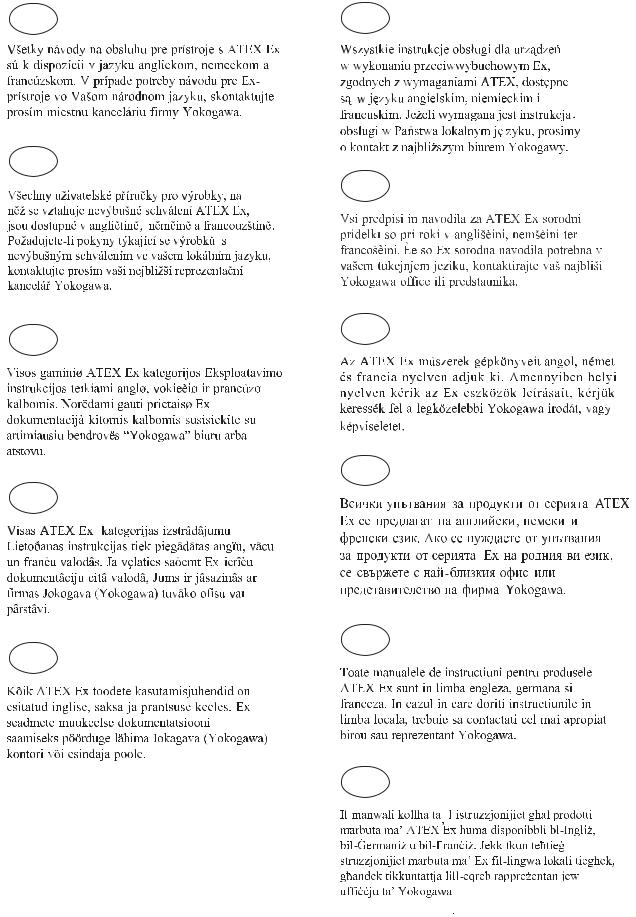
SK
CZ
LT
LV
EST
PL
SLO
H
BG
RO
M
IM 12D08B02-01E
CONFIGURATION CHECKLIST FOR SC202
Primary choices |
default |
alternatives |
reference on page |
menu |
Measurement |
Conductivity |
Resistivity |
5.8- 5.9 |
SC 01 |
Range |
0-1000 μS/cm |
max. 1999 mS/cm |
5.3 |
“range” |
Temperature unit |
Celsius |
Fahrenheit |
5.10- 5.11 |
SC 11 |
Sensor |
|
|
|
|
Cell constant |
0.1 /cm |
any value between 0.08 |
5.8-5.9, 6.1- 6.3 |
SC 03 |
|
|
and 50 |
|
|
Sensor type |
2-electrode |
4- electrode |
5.8- 5.9 |
SC 02 |
Temperature compensator |
Pt1000 |
Ni100, Pt100, 8k55, Pb36 |
5.10-5.11 |
SC 10 |
Choices |
|
|
|
|
Communication |
enabled |
disable HART(R), PH201*B |
5.19 |
SC 6062 |
Burn out |
inactive |
HI or LO output on fail |
5.14- 5.15 |
SC 32 |
Temperature compensation |
NaCl in water |
fixed T.C., matrix |
5.12, 5.13, 5.5 |
SC 2028; “temp” |
USP functionality |
inactive |
Fail if USP limits are |
9.1, 9.2, 5.17 |
SC 57 |
|
|
exceeded |
|
|
HOLD during maintenance |
inactive |
HOLD last value or fixed |
5.17, 5.3- 5.4 |
“hold”, SC 50 |
|
|
value |
|
|
Calibration temperature |
inactive |
adjustment +/- 15 °C |
5.11 |
SC 12 |
ZERO calibration |
inactive |
adjustment +/-1 μS/cm |
5.9 |
SC 04 |
Diagnostics |
hard alarm on |
hard or soft choices |
5.17 |
SC 53 |
|
all errors |
|
|
|
Cell fouling alarm |
active |
except E13 inactive |
5.9 |
SC 05 |
Password protection |
inactive |
password for different levels |
5.17 |
SC 52 |
Output in Concentration units |
inactive |
linearization of output, w% |
5.14 - 5.17 |
SC 31/35/55 |
|
|
on LCD |
|
|
IM 12D08B02-01E
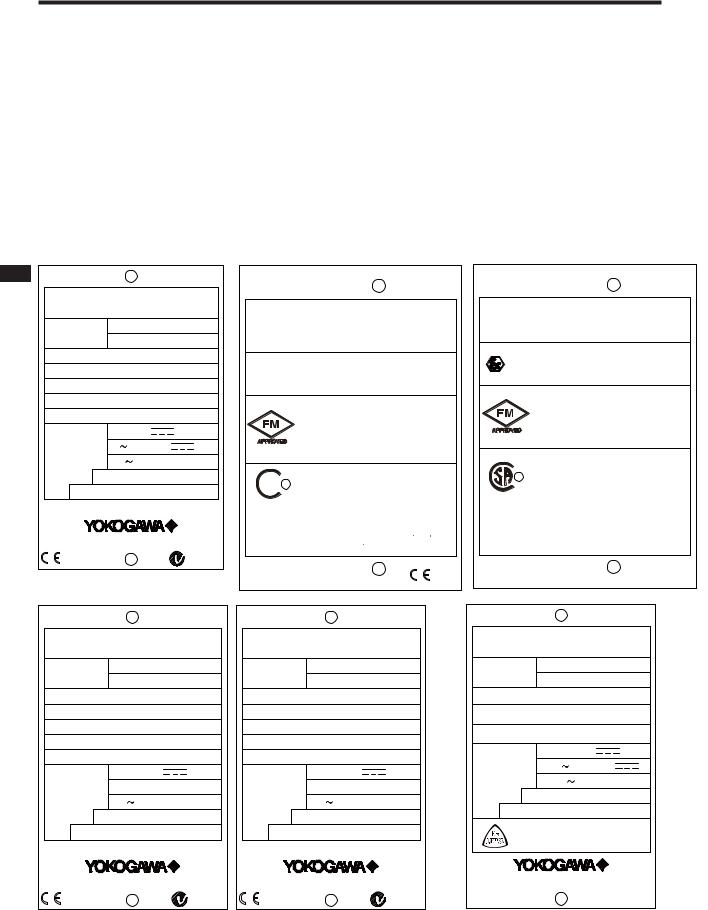
Introduction 1-1
1. INTRODUCTION AND GENERAL DESCRIPTION
The Yokogawa EXA 202 is a 2-wire transmitter designed for industrial process monitoring, measurement and control applications. This user’s manual contains the information needed to install, set up, operate and maintain the unit correctly. This manual also includes a basic troubleshooting guide to answer typical user questions.
Yokogawa can not be responsible for the performance of the EXA analyzer if these instructions are not followed.
1-1. Instrument check
Upon delivery, unpack the instrument carefully and inspect it to ensure that it was not damaged during shipment. If damage is found, retain the original packing materials (including the outer box) and then immediately notify the carrier and the relevant Yokogawa sales office.
Make sure the model number on the textplate affixed to the side of the instrument agrees with your order. Examples of nameplates are shown below.
mA
CONDUCTIVITY TRANSMITTER
MODEL SC202
SUFFIX
SUPPLY |
24V DC |
OUTPUT |
4 20mA DC |
AMB.TEMP. |
-10 55°C |
STYLE |
|
No. |
|
Made in Japan Tokyo 180-8750 JAPAN
N200
DISSOLVED OXYGEN TRANSMITTER
MODEL SC202G-F
SUFFIX
SUPPLY |
9 TO 32VDC |
OUTPUT |
FF-TYPE113 |
AMB.TEMP. |
-10 55°C |
STYLE |
|
No. |
|
Made in Japan Tokyo 180-8750 JAPAN
N200
Figure 1-1. Nameplate
No. IECEx KEM 06.0053X Zone 0 Ex ia IIC T4
Zone 0 Ex ia IIC T6 for Ta:40°C IP65
SEE CONTROL DRAWING
 II 1G
II 1G

 R
R
LR81741 C
No. KEMA 06ATEX0220 X Ex ia IIC T4
Ex ia IIC T6 for Ta:40°C
SEE CONTROL DRAWING IP65
IS CL I, DIV 1, GP ABCD AND AEx ia IIC
T4 Type 4X
Install per CONTROL DRAWING IKE026-A10 P.5 to P.6
CL I, DIV 1, GP ABCD Ex ia IIC T4
Ex ia IIC T6 for Ta:40°C
SEE CONTROL DRAWING IP65 Type 3S
WARNING |
AVERTISSEMENT |
Substitution of |
La substitution de composants |
components may impair |
peut compromeltre la securite |
intrinsic safety |
intrinseque. |
SC202S-A |
0344 |
DISSOLVED OXYGEN TRANSMITTER
MODEL SC202G-P
SUFFIX
SUPPLY |
9 TO 32VDC |
OUTPUT |
PROFIBUS-PA |
AMB.TEMP. |
-10 55°C |
STYLE |
|
No. |
|
Made in Japan Tokyo 180-8750 JAPAN
N200
No. IECEx KEM 06.0053X
Ex nA[nL] IIC T4
Ex nA[nL] IIC T6 for Ta:40°C
IP65
SEE CONTROL DRAWING
No. KEMA 06ATEX0221
EEx nA[nL] IIC T4
II 3 G EEx nA[nL] IIC T6 for Ta:40°C
IP65
SEE CONTROL DRAWING
NI CL I, DIV 2, GP ABCD AND
CL I, ZN 2, GP IIC
T4
Type 4X
Install per CONTROL DRAWING
IKE026-A10 P.7 to P.8
Ex nA[nL] IIC
NI CL I, DIV 2, GP ABCD
T4
RT6 for Ta:40°C IP65 Type 3S
LR81741 C SEE CONTROL DRAWING
WARNING |
AVERTISSEMENT |
|
La substitution de composants |
||
Substitution of |
||
peut rendre ce materiel |
||
components may |
||
inacceptable pour les |
||
impair suitability |
||
emplacements de |
||
for class I, Division 2. |
||
Classe I, Division 2. |
||
|
SC202S-N
CONDUCTIVITY TRANSMITTER
MODEL SC202S-K SUFFIX
SUPPLY |
24V DC |
OUTPUT |
4 20mA DC |
AMB.TEMP. |
-10 55°C |
STYLE |
|
No. |
|
|
Cert No. GYJ081157X |
|
Ex ia IIC T4 |
|
Ex ia IIC T6 for Ta:40˚C |
|
SEE USER’S MANUAL BEFORE USE |
Made in Japan Tokyo 180-8750 JAPAN
IM 12D08B02-01E
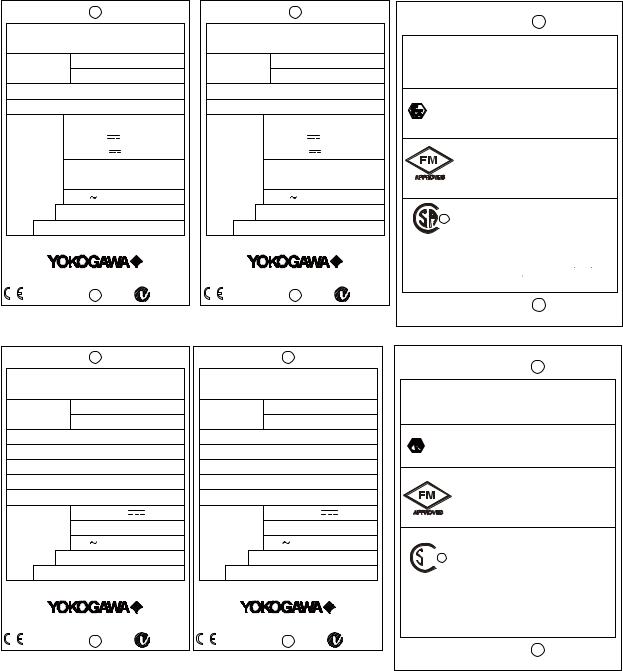
1-2 Introduction
CONDUCTIVITY TRANSMITTER CONDUCTIVITY TRANSMITTER
MODEL |
SC202S-F |
MODEL |
SC202S-P |
||
SUFFIX |
|
|
SUFFIX |
|
|
SUPPLY |
FISCO |
|
SUPPLY |
FISCO |
|
|
17.5VDC |
/380mA/5.32W |
|
17.5VDC |
/380mA/5.32W |
|
or 24VDC |
/250mA/1.2W |
|
or 24VDC |
/250mA/1.2W |
OUTPUT |
FF-TYPE111 or 511 |
OUTPUT |
PROFIBUS-PA |
||
|
Li=0 μH, |
Ci=220pF |
|
Li=0 μH, |
Ci=220pF |
AMB.TEMP. |
-10 55°C |
|
AMB.TEMP. |
-10 55°C |
|
STYLE |
|
|
STYLE |
|
|
No. |
|
|
No. |
|
|
Made in Japan Tokyo 180-8750 JAPAN |
Made in Japan Tokyo 180-8750 JAPAN |
||||
0344 |
|
N200 |
0344 |
|
N200 |
FISCO field device
No. IECEx KEM 07.0027X
Zone 0 Ex ia IIC T4
IP65
SEE CONTROL DRAWING
No. KEMA 07ATEX0050 X
II 1G Ex ia IIC T4
SEE CONTROL DRAWING IP65
IS CL I, DIV 1, GP ABCD AND AEx ia IIC
T4 Type 4X
Install per CONTROL DRAWING IKE027-A10 P.5 to P.8
|
CL I, DIV 1, GP ABCD |
|
R Ex ia IIC T4 |
|
|
|
SEE CONTROL DRAWING |
|
LR81741 C |
IP65 Type 3S |
|
WARNING |
|
AVERTISSEMENT |
Substitution of |
|
La substitution de composants |
components may impair |
peut compromeltre la securite |
|
intrinsic safety |
|
intrinseque. |
SC202S-F/-P
CONDUCTIVITY TRANSMITTER |
CONDUCTIVITY TRANSMITTER |
||
MODEL |
SC202S-B |
MODEL |
SC202S-D |
SUFFIX |
|
SUFFIX |
|
SUPPLY |
9 TO 32VDC |
SUPPLY |
9 TO 32VDC |
OUTPUT |
FF-TYPE 113 |
OUTPUT |
PROFIBUS-PA |
AMB.TEMP. |
-10 55°C |
AMB.TEMP. |
-10 55°C |
STYLE |
|
STYLE |
|
No. |
|
No. |
|
Made in Japan Tokyo 180-8750 JAPAN |
Made in Japan Tokyo 180-8750 JAPAN |
||
|
N200 |
|
N200 |
Figure 1-2. Nameplate
FNICO field device
 II 3 G
II 3 G

 R
R
LR81741 C
No. IECEx KEM 07.0027X Ex nA[nL] IIC T4
Ex nA[nL] IIC T6 for Ta:40°C IP65
SEE CONTROL DRAWING
No. KEMA 07ATEX0051 EEx nA[nL] IIC T4
EEx nA[nL] IIC T6 for Ta:40°C IP65
SEE CONTROL DRAWING
NI CL I, DIV 2, GP ABCD AND CL I, ZN 2, GP IIC
T4 Type 4X
Install per CONTROL DRAWING IKE027-A10 P.9 to P.10
Ex nA[nL] IIC
NI CL I, DIV 2, GP ABCD T4
T6 for Ta:40°C IP65 Type 3S
SEE CONTROL DRAWING
WARNING |
AVERTISSEMENT |
|
La substitution de composants |
||
Substitution of |
||
peut rendre ce materiel |
||
components may |
||
inacceptable pour les |
||
impair suitability |
||
emplacements de |
||
for class I, Division 2. |
||
Classe I, Division 2. |
||
|
SC202S-B/-D
NOTE: Check that all the parts are present, including mounting hardware, as specified in the option codes at the end of the model number.
For a description of the model codes, refer to Chapter 2 of this manual under General Specifications.
Basic Parts List:Transmitter SC202 User’s Manual English
Optional mounting hardware when specified (See model code)
IM 12D08B02-01E
Introduction 1-3
1-2. Application
The EXA transmitter is intended to be used for continuous on-line measurement in industrial installations. The unit combines simple operation and microprocessor-based performance with advanced selfdiagnostics and enhanced communications capability to meet the most advanced requirements. The measurement can be used as part of an automated process control system. It can also be used to indicate dangerous limits of a process, to monitor product quality, or to function as a simple controller for a dosing/neutralisation system.
Yokogawa designed the EXA analyzer to withstand harsh environments. The transmitter may be installed either indoors or outside because the IP65 (NEMA 4X) housing and cabling glands ensure the unit is adequately protected. The flexible polycarbonate window on the front door of the EXA allows pushbutton access to the keypad, thus preserving the water and dust protection of the unit even during routine maintenance operations.
A variety of EXA hardware is optionally available to allow wall, pipe, or panel mounting. Selecting a proper installation site will permit ease of operation. Sensors should normally be mounted close to the transmitter in order to ensure easy calibration and peak performance.
The EXA is delivered with a general purpose default setting for programmable items. (Default settings are listed in Chapter 5 and again in Chapter 11). While this initial configuration allows easy start-up, the configuration should be adjusted to suit each particular application. An example of an adjustable item is the type of temperature sensor used. The EXA can be adjusted for any one of five different types of temperature sensors.
To record such configuration adjustments, write changes in the space provided in Chapter 11 of this manual. Because the EXA is suitable for use as a monitor, a controller or an alarm instrument, program configuration possibilities are numerous.
Details provided in this user’s manual are sufficient to operate the EXA with all Yokogawa sensor systems and a wide range of third-party commercially available probes. For best results, read this manual in conjunction with the corresponding sensor user’s manual.
Yokogawa designed and built the EXA to meet the CE regulatory standards. The unit meets or exceeds stringent requirements of EN61326 Class A without compromise, to assure the user of continued accurate performance in even the most demanding industrial installations.
IM 12D08B02-01E
1-4 Introduction
IM 12D08B02-01E
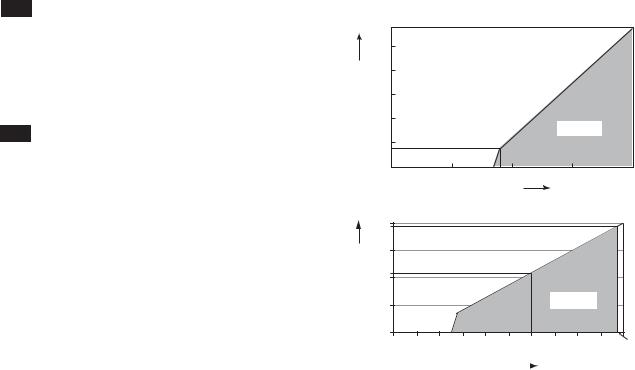
|
Specifications 2-1 |
2. GENERAL SPECIFICATIONS |
|
2-1. Specifications |
5 preprogrammed matrixes and a 25- |
A. Input specifications |
point user-programmable matrix. |
: Two or four electrodes measurement with |
|
square wave excitation. Cell constants from |
H. Logbook |
0.008 to 50 cm-1. |
: Software record of important events and diag- |
|
nostic data. Available through HART® link, |
B. Detection method |
with diagnostic information available in the |
: Frequency, read-pulse position and reference |
display. |
voltage are dynamically optimized. |
|
|
|
|
I. |
Display |
|
|
|
|
|
|
C. Input ranges |
|
: Custom liquid crystal display, with a main dis- |
||||||
|
- Conductivity : |
|
play of 31/2 digits 12.5 mm high. Message dis- |
||||||
|
Minimum |
: 0 μS/cm |
|
play of 6 alphanumeric characters, 7 mm high. |
|||||
|
Maximum |
: 200 mS x (Cell constant) |
|
Warning flags and units (mS/cm, kΩ·cm, μS/ |
|||||
|
|
(overrange 1999 mS / cm). |
|
cm and MΩ·cm) as appropriate. |
|
||||
|
- Resistivity |
: |
|
|
|
|
|
|
|
|
Minimum |
: 0.005 kΩ/ (Cell constant) |
J. Power supply |
|
|
|
|
||
|
Maximum |
: 999 MΩ x cm |
|
: Nominal 24 volt DC loop powered system. |
|||||
|
- Temperature |
|
SC202G |
; 17 to 40 volts, see Fig.2-1 |
|||||
|
Pt1000 |
: -20 to +250 °C (0 to 500 °F) |
|
SC202S |
: 17 to 31.5 volts, see Fig.2-2 |
||||
|
Pt100 and Ni100 : -20 to +200 °C (0 to 400 °F) |
|
Maximum load resistance |
|
|
||||
|
8K55 NTC |
: -10 to +120 °C (10 to 250 °F) |
|
For the SC202G, see Fig. 1 |
|
|
|||
|
PB36 NTC : -20 to +120 °C (0 to 250 °F) |
|
200Ω or less with the PH201G |
|
|||||
mA D. Output Span |
|
50Ω or less with the SDBT |
|
|
|||||
|
For the SC202S, see Fig. 2-2 |
|
|
||||||
|
- Conductivity : - min 0.01μS/cm |
|
1150 |
|
|
|
|
|
|
|
|
: - max. 1999 mS/cm. (max 90% |
|
1000 |
|
|
|
|
|
|
|
zero suppression) |
(Ω) |
800 |
|
|
|
|
|
|
- Resistivity |
: - min 0.001kΩxcm |
|
|
|
|
|
||
|
|
: - max. 999 MΩ x cm. (max 90% |
Resistance |
600 |
|
|
|
Possible |
|
|
|
zero suppression) |
400 |
|
|
|
|
||
|
|
|
|
|
|
|
|
||
mA |
|
|
|
|
|
|
|
|
|
E. Transmission Signal |
Load |
200 |
|
|
|
|
|
||
|
: Isolated output of 4-20 mA DC |
150 |
|
|
|
|
|
||
|
Burn up (21 mA) or Burn down |
|
00 |
10 |
17 18 20 |
|
30 |
40 |
|
|
(3.6 mA when HART® or distributor comm. is |
|
|
|
Voltage (V) |
|
|
F06.EPS |
|
|
non-used, 3.9 mA when HART® or distributor |
Fig.2-1 Supply voltage/ load diagram for the SC202G |
|||||||
|
comm. is used) or pulse of 21 mA to signal |
||||||||
|
|
800 |
|
|
|
|
|
||
|
failure. |
|
|
|
|
|
|
|
|
|
|
|
775 |
|
|
|
|
|
|
|
|
|
Ω) |
600 |
|
|
|
|
|
|
F. Temperature compensation |
( |
425 |
|
|
|
|
|
|
|
Resistance |
|
|
|
Possible |
|
|||
|
under C (inputs). |
200 |
|
|
|
|
|||
|
: Automatic, for temperature ranges mentioned |
|
400 |
|
|
|
|
|
|
|
- Reference temp. |
Load |
|
|
|
|
|
|
|
|
: programmable from 0 to 100 °C or 30 to 210 °F |
0 |
17 |
|
|
|
3231.5 V |
||
|
(default 25 °C). |
|
12 |
20 |
24 |
28 |
|||
|
|
16 |
|||||||
G. Compensation algorithm |
|
Voltage (V) |
|
|
|
|
|
|
|||
Fig.2-2 Supply voltage/ load diagram for the SC202S |
|||||
-NaCl |
: According IEC 60746-3 NaCl tables |
K. Input isolation |
|
||
|
(default). |
|
|||
-T.C. |
: Two independent user program- |
: 1000 VDC |
|
|
|
|
mable temperature coefficients, |
L. Weight |
|
|
|
|
from -0.0% to 3.5% per °C (°F) |
|
|
|
|
|
by adjustment or calibration. |
Body weight |
: |
|
approx. 1.6 kg |
- Matrix |
: Conductivity function of concentra- |
Mounting brackets weight: |
approx. 0.7 kg. |
||
|
tion and temperature. Choice out of |
|
|
|
|
IM 12D08B02-01E

2-2 Specifications
2-2. Operating specifications
A.Performance (under reference conditions with sensor simulation)
Conductivity (2 μS x K cm-1 to 200 mS x K cm-1)
- Accuracy : ±0.5% F.S. Conductivity (1 μS x K cm-1 to 2 μS x K cm-1)
- Accuracy : ±1% F.S.
Resistivity (0.005kΩ/ K cm-1 to 0.5MΩ/ K cm-1)
- Accuracy |
: |
±0.5% F.S. |
|
Resistivity (0.5MΩ/ K cm-1 to 1MΩ/ K cm-1) |
|
||
- Accuracy |
: |
±1% F.S. |
|
Temperature (Pt1000Ω, PB36 NTC, Ni100) |
|
||
- Accuracy |
: |
±0.3°C |
|
Temperature (Pt100Ω, 8.55kΩ NTC) |
|
||
mA |
|||
- Accuracy |
: |
±0.4°C |
|
Temperature compensation |
|
||
- NaCl table |
: |
±1 % |
|
- Matrix |
: |
±3 % |
|
Note on performance specifications:
"F.S." means maximum setting value of transmitter output. "K" means cell constant. YOKOGAWA provides conductivity sensors which cell constant are 0.1 to 10 cm-1.
The following tolerance is added to above performance.
mA output tolerance : ± 0.02 mA of "4 - 20 mA"
Step response: 90 % (< 2 decades) in 7 seconds
B.Ambient operating temperature
:-10 to +55 °C (-10 to 130 ºF)
C.Storage temperature
:-30 to +70 °C (-20 to 160 ºF)
D.Humidity
:10 to 90% RH non-condensing
E.Housing
:Cast aluminium case with chemically resistant coating, cover with flexible polycarbonate window. Case color is off-white (Equivalent to Munsell 2.5Y8.4/1.2) and cover is Deepsea Moss green (Equivalent to Munsell 0.6GY3.1/2.0). Cable entry is via two PG13.5 nylon glands. Weather resistant to IP65 and
NEMA 4X standards. Pipe wall or panel mounting, using optional hardware.
F.Data protection
:EEPROM for configuration and logbook
G.Automatic safeguard
:Return to measuring mode when no keystroke is made for 10 min.
IM 12D08B02-01E
H.Operation protection
:3-digit programmable password.
I.EMC Conformity standards 

 ,
,
EN 61326-1 Class A, Table 2 (For use in industrial locations) EN 61326-2-3
EN 61326-2-5 (pending)
 CAUTION
CAUTION
This instrument is a Class A product, and it is designed for use in the industrial environment. Please use this instrument in the industrial environment only.
J. Explosionproof type
Refer to control drawings.
Item |
|
Description |
|
Code |
|
|
|
|
FM Intrinsically safe Approval |
|
|
|
|
|
|
Applicable standard: FM3600, FM3610, FM3810 |
|
|
|
|
|
|
Intrinsically Safe for Class I, Division 1, Groups ABCD |
|
|
|
|
|
|
Class I, Zone 0, AEx ia IIC |
|
|
|
|
|
|
Temp. Class: T4, Amb. Temp.: -10 to 55°C |
|
-A |
|
|
|
|
Intrinsically Safe Apparatus Parameters |
|
|
|
|
Factory |
Vmax=31.5 V, Imax=100 mA, |
|
|
|
||
Pmax=1.2 W, Ci=22 nF, Li=35 μH |
|
|
|
|||
Mutual (FM) |
|
|
|
|||
|
|
FM Non-incendive safe Approval |
|
|
|
|
|
|
Applicable standard: FM3600, FM3611, FM3810 |
|
|
|
|
|
|
Non-incendive Safe for Class I, Division 2, |
|
|
|
|
|
|
Groups ABCD, Zone 2 |
|
-N |
|
|
|
|
Temp. Class: T4, Amb. Temp.: -10 to 55°C |
|
|
||
|
|
Non-incendive Safe Apparatus Parameters |
|
|
|
|
|
|
Vmax=31.5 V, Ci=22 nF, Li=35 μH |
|
|
|
|
|
|
|
|
|
|
|
|
|
CENELEC ATEX (KEMA) Intrinsically safe Approval |
|
|
|
|
|
|
Applicable standard: EN60079-0, EN50020 |
|
|
|
|
|
|
|
EN60079-26 |
|
|
|
|
|
Certificate: KEMA 06ATEX0220 X |
|
-A |
|
|
|
|
Ex ia IIC, Group: II, Category: 1G |
|
|
||
|
|
|
|
|
||
CENELEC |
Temp. Class: T4, Amb. Temp.: -10 to 55°C |
|
|
|
||
|
T6, Amb. Temp.: -10 to 40°C |
|
|
|
||
ATEX |
Ui=31.5 V, Ii=100 mA, Pi=1.2 W, Ci=22 nF, Li=35 μH |
|
|
|
||
|
|
|
|
|
|
|
|
|
CENELEC ATEX (KEMA) Type of protection "n" |
|
|
|
|
|
|
Applicable standard: EN60079-0:2006, |
|
|
|
|
|
|
|
EN60079-15:2003 |
|
|
|
|
|
Certificate: KEMA 06ATEX0221 |
|
-N |
|
|
|
|
EEx nA [nL] IIC, Group: II, Category: 3G |
|
|
||
|
|
|
|
|
||
|
|
Temp. Class: T4, Amb. Temp.: -10 to 55°C |
|
|
|
|
|
|
|
T6, Amb. Temp.: -10 to 40°C |
|
|
|
|
|
Ui=31.5 V, |
Ci=22 nF, Li=35 μH |
|
|
|
|
|
|
|
|
2.EPS |
|
|
|
|
|
|
|
|
Item |
|
Description |
|
Code |
||
|
|
FM Intrinsically safe Approval |
|
|
|
|
|
|
Applicable standard: FM3600, FM3610, FM3810 |
|
-P |
||
|
|
Intrinsically Safe for Class I, Division 1, Groups ABCD |
|
|||
|
|
Class I, Zone 0, AEx ia IIC |
|
|
|
|
|
|
Temp. Class: T4, Amb. Temp.: -10 to 55°C |
|
or |
||
|
|
Intrinsically Safe Apparatus Parameters |
|
|
|
|
|
|
Entity |
Vmax=24 V, Imax=250 mA, |
|
-F |
|
|
|
Pmax=1.2 W, Ci=220 pF, Li=0 μH |
|
|||
|
|
|
|
|||
Factory |
FISCO |
Vmax=17.5 V, Imax=380 mA, |
|
|
|
|
Mutual (FM) |
|
|
Pmax=5.32 W, Ci=220pF, Li=0 μH |
|
|
|
|
|
FM Non-incendive safe Approval |
|
|
|
|
|
|
Applicable standard: FM3600, FM3611, FM3810 |
|
-B |
||
|
|
Non-incendive Safe for Class I, Division 2, |
|
|||
|
|
Groups ABCD, Zone 2 |
|
|
|
|
|
|
Temp. Class: T4, Amb. Temp.: -10 to 55°C |
|
or |
||
|
|
Non-incendive Safe Apparatus Parameters |
|
|||
|
|
Entity |
Vmax=32 V, Pmax=1.2 W, |
|
|
|
|
|
Ci=220 pF, Li=0 μH |
|
-D |
||
|
|
|
|
|||
|
|
FNICO |
Vmax=32 V, Pmax=5.32 W, |
|
||
|
|
|
|
|
||
|
|
Ci=220 pF, Li=0 μH |
|
|
|
|
|
|
|
|
|
|
|
|
|
|
|
|
FM.EPS |
|
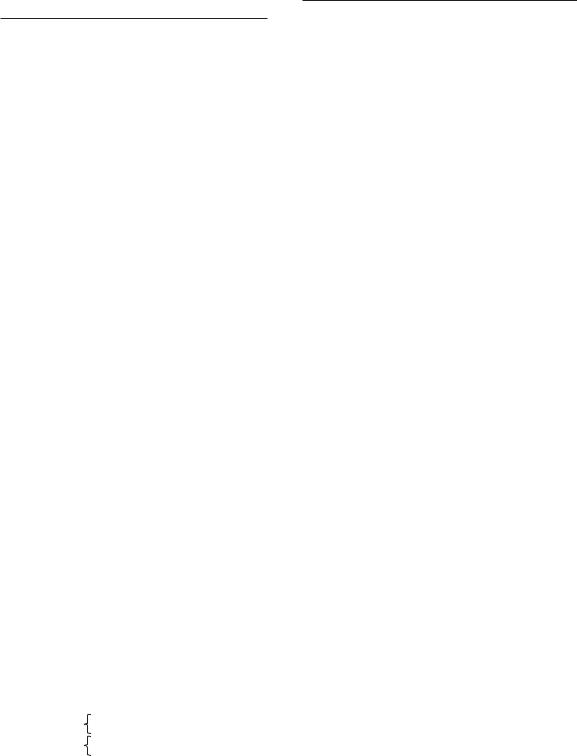
|
|
|
Item |
|
|
Description |
Code |
|
|
|
|
|
|
CENELEC ATEX (KEMA) Intrinsically safe Approval |
|
|
|
|
|
|
CENELEC |
|
Applicable standard: EN60079-0, EN50020 |
|
|
|
|
|
|
|
|
EN60079-26 |
|
|
|
|
|
|
ATEX |
|
|
|
|
|
|
|
|
|
Certificate: KEMA 07ATEX0050 X |
|
|
||
|
|
|
Entity |
|
-P |
|
||
|
|
|
|
Ex ia IIC, Group: II, Category: 1G |
|
|||
|
|
|
|
|
Temp. Class: T4, Amb. Temp.: -10 to 55°C |
|
|
|
|
|
|
|
|
Ui=24 V, Ii=250 mA, Pi=1.2 W, Ci=220 pF, Li=0 μH |
or |
|
|
|
|
|
|
|
CENELEC ATEX (KEMA) Intrinsically safe Approval |
|
||
|
|
|
|
|
|
|
||
|
|
|
CENELEC |
|
Applicable standard: EN60079-0, EN50020 |
|
|
|
|
|
|
|
|
EN60079-26, EN60079-27 |
-F |
|
|
|
|
|
ATEX |
|
Certificate: KEMA 07ATEX0050 X |
|
|
|
|
|
|
FISCO |
|
Ex ia IIC, Group: II, Category: 1G |
|
|
|
|
|
|
|
|
Temp. Class: T4, Amb. Temp.: -10 to 55°C |
|
|
|
|
|
|
|
|
Ui=17.5 V, Ii=380 mA, Pi=5.32 W, Ci=220 pF, Li=0 μH |
|
|
|
|
|
|
|
|
CENELEC ATEX (KEMA) Type of protection "n" |
|
|
|
|
|
|
|
|
Applicable standard: EN60079-0:2006, |
-B |
|
|
|
|
|
|
|
|
EN60079-15:2003 |
|
|
|
|
|
CENELEC |
|
Certificate: KEMA 07ATEX0051 |
or |
|
|
|
|
|
ATEX |
|
EEx nA [nL] IIC, Group: II, Category: 3G |
|
||
|
|
|
|
|
Temp. Class: T4, Amb. Temp.: -10 to 55°C |
|
|
|
|
|
|
|
|
|
T6, Amb. Temp.: -10 to 40°C |
-D |
|
|
|
|
|
|
Ui=32 V, Ci=220 pF, Li=0 μH |
|
||
|
|
|
|
|
|
|
||
|
|
|
|
|
|
|
ATEX.EPS |
|
|
|
|
|
|
|
|
|
|
mA |
Item |
|
|
Description |
Code |
|||
|
|
|
|
CSA Intrinsically safe Approval |
|
|
||
|
|
|
|
Applicable standard: C22.2, No. 0-M1991, |
|
|
||
|
|
|
|
|
C22.2, No. 04-M2004, C22.2, No. 157-M1992, |
|
|
|
|
|
|
|
|
C22.2, No. 61010-1 |
-A |
||
|
|
|
|
Ex ia Class I, Division 1, Groups ABCD |
||||
|
|
|
|
|
|
|||
|
|
|
|
Ex ia IIC |
|
|
|
|
|
|
|
|
Temp. Class: T4, Amb. Temp.: -10 to 55°C |
|
|
||
|
|
|
Canadian |
|
|
T6, Amb. Temp.: -10 to 40°C |
|
|
|
|
|
Ui(Vmax)=31.5 V, Ii(Imax)=100 mA, |
|
|
|||
|
|
|
Standards |
Pi(Pmax)=1.2 W, Ci=22 nF, Li=35 μH |
|
|
||
|
|
|
Association |
CSA Non-incendive safe Approval or |
|
|
||
|
|
|
(CSA) |
type of protection "n" |
|
|
||
|
|
|
|
Applicable standard: C22.2, No.0-M1991, |
|
|
||
|
|
|
|
|
C22.2, No.04-M2004, C22.2, No.157-M1992, |
-N |
||
|
|
|
|
|
C22.2, No.213-M1987, C22.2, No.61010-1 |
|||
|
|
|
|
Class I, Division 2, Groups ABCD |
|
|
||
|
|
|
|
Ex nA [nL] IIC |
|
|
||
|
|
|
|
Temp. Class: T4, Amb. Temp.: -10 to 55°C |
|
|
||
|
|
|
|
|
|
T6, Amb. Temp.: -10 to 40°C |
|
|
|
|
|
|
Ui(Vmax)=31.5 V, Ci=22 nF, Li=35 μH |
|
|
||
|
|
|
|
|
|
|
|
|
|
|
|
|
IECEx Intrinsically safe |
|
|
||
|
|
|
|
Applicable standard: IEC 60079-0, IEC60079-11, |
|
|
||
|
|
|
|
|
|
IEC60079-26 |
|
|
|
|
|
|
Certificate: IECEx KEM 06.0053X |
-A |
|||
|
|
|
|
Zone 0 Ex ia IIC |
||||
|
|
|
|
|
|
|||
|
|
|
|
Temp. Class: T4, Amb. Temp.: -10 to 55°C |
|
|
||
|
|
|
|
|
|
T6, Amb. Temp.: -10 to 40°C |
|
|
|
|
|
IECEx |
Ui=31.5 V, Ii=100 mA, Pi=1.2 W, Ci=22 nF, Li=35 μH |
|
|
||
|
|
|
Scheme |
IECEx Type of protection "n" |
|
|
||
|
|
|
|
Applicable standard: IEC 60079-15:2001, |
|
|
||
|
|
|
|
|
|
IEC 60079-0:2004 |
|
|
|
|
|
|
Certificate: IECEx KEM 06.0053X |
-N |
|||
|
|
|
|
Ex nA [nL] IIC |
||||
|
|
|
|
|
|
|||
|
|
|
|
Temp. Class: T4, Amb. Temp.: -10 to 55°C |
|
|
||
|
|
|
|
|
|
T6, Amb. Temp.: -10 to 40°C |
|
|
|
|
|
|
Ui=31.5 V, Ci=22 nF, Li=35 μH |
|
|
||
|
|
|
|
|
|
|
T12E.EPS |
|
|
|
|
|
|
|
|
|
|
|
|
|
Item |
|
|
Description |
Code |
|
|
|
|
|
CSA Intrinsically safe Approval |
|
|
||
|
|
|
|
Applicable standard: C22.2, No. 0-M1991, |
-P |
|||
|
|
|
|
|
C22.2, No. 04-M2004, C22.2, No. 157-M1992, |
|||
|
|
|
|
|
C22.2, No. 61010-1 |
|
|
|
|
|
|
|
Ex ia Class I, Division 1, Groups ABCD |
or |
|||
|
|
|
|
Ex ia IIC |
|
|||
|
|
|
|
|
|
|
||
|
|
|
|
Temp. Class: T4, Amb. Temp.: -10 to 55°C |
|
|
||
|
|
|
Canadian |
Entity |
Ui(Vmax)=24 V, Ii(Imax)=250 mA, |
-F |
||
|
|
|
Pi(Pmax)=1.2 W, Ci=220 pF, Li=0 μH |
|
|
|||
|
|
|
Standards |
|
|
|
|
|
|
|
|
FISCO |
Ui(Vmax)=17.5 V, Ii(Imax)=380 mA, |
|
|
||
|
|
|
Association |
|
|
|||
|
|
|
(CSA) |
|
|
Pi(Pmax)=5.32 W, Ci=220 pF, Li=0 μH |
|
|
|
|
|
CSA Non-incendive safe Approval or |
|
|
|||
|
|
|
|
|
|
|||
|
|
|
|
type of protection "n" |
|
|
||
|
|
|
|
Applicable standard: C22.2, No.0-M1991, |
-B |
|||
|
|
|
|
|
C22.2, No.04-M2004, C22.2, No.157-M1992, |
|
|
|
|
|
|
|
|
C22.2, No.213-M1987, C22.2, No.61010-1 |
or |
||
|
|
|
|
Class I, Division 2, Groups ABCD |
||||
|
|
|
|
Ex nA [nL] IIC |
|
|
||
|
|
|
|
Temp. Class: T4, Amb. Temp.: -10 to 55°C |
-D |
|||
|
|
|
|
|
|
T6, Amb. Temp.: -10 to 40°C |
||
|
|
|
|
|
|
|
|
|
|
|
|
|
Entity: |
Ui(Vmax)=32 V, Ci=220 pF, Li=0 μH |
|
|
|
|
|
|
|
FNICO: |
Ui(Vmax)=32 V, Ci=220 pF, Li=0 μH |
|
|
|
|
|
Specifications 2-3 |
||
|
|
|
|
|
Item |
Description |
Code |
|
|
|
|
IECEx Intrinsically safe |
|
|
IECEx |
Applicable standard: IEC 60079-0, IEC60079-11, |
|
|
|
IEC60079-26 |
|
|
||
Scheme |
Certificate: IECEx KEM 07.0027X |
-P |
|
|
Entity |
Zone 0 Ex ia IIC |
|
||
|
|
Temp. Class: T4, Amb. Temp.: -10 to 55°C |
|
|
|
|
Ui=24 V, Ii=250 mA, Pi=1.2 W, Ci=220 pF, Li=0 μH |
or |
|
|
|
IECEx Intrinsically safe |
|
|
|
|
|
|
|
|
|
Applicable standard: IEC 60079-0, IEC60079-11, |
|
|
IECEx |
IEC60079-26, IEC60079-27 |
-F |
|
|
Scheme |
Certificate: IECEx KEM 07.0027X |
|
|
|
FISCO |
Zone 0 Ex ia IIC |
|
|
|
|
|
Temp. Class: T4, Amb. Temp.: -10 to 55°C |
|
|
|
|
Ui=17.5 V, Ii=380 mA, Pi=5.32 W, Ci=220 pF, Li=0 μH |
|
|
|
|
IECEx Type of protection "n" |
-B |
|
|
|
Applicable standard: IEC 60079-15:2001, |
|
|
|
|
IEC 60079-0:2004 |
|
|
IECEx |
Certificate: IECEx KEM 07.0027X |
or |
|
|
Scheme |
Ex nA [nL] IIC |
|
||
|
|
|||
|
|
Temp. Class: T4, Amb. Temp.: -10 to 55°C |
|
|
|
|
T6, Amb. Temp.: -10 to 40°C |
-D |
|
|
|
Ui=32 V, Ci=220 pF, Li=0 μH |
|
|
|
|
|
|
|
|
|
|
IEC.EPS |
|
mA |
|
|
||
|
|
|
|
|
NEPSI Certification (SC202S-K) |
|
|
||
NEPSI Intrinsically Safe Type |
|
|
||
Cert No. GYJ081157X |
|
|
||
• Applicable Standard: |
|
|
||
|
GB3836.1-2000, GB3836.4-2000 |
|
|
|
•Type of Protection and Marking Code: Ex ia IIC T4/T6
•Ambient Temperature :
T6; –10 to 40°C, T4; –10 to 55°C
Note 1 Entity Parameters
•Intrinsically safe input parameters (terminal + and -):
Maximum Input Voltage (Ui) = 31.5 V Maximum Input Current (Ii) = 100 mA Maximum Input Power (Pi) = 1.2 W Maximum Internal Capacitance (Ci) = 22 nF Maximum Internal Inductance (Li) = 35 μH
•Intrinsically safe output parameters and maximum external parameters
(terminal 11 and 16):
Uo=14.4 V, Io=13 mA, Po=185 mW, Co=59 nF, Lo=200 mH
Note 2 Installation
•Electrostatic charges on the display window shall be avoided.
•The external earth connection facility shall be connected reliably.
•The instrument modification or parts replacement by other than authorized representative of Yokogawa Electric Corporation and will void NEPSI Intrinsically safe certification.
•The user shall not change the configuration in order to maintain/ensure the explosion protection performance of the equipment. Any change may impair safety.
•For installation, use and maintenance of
the product, the end user shall observe the instruction manual and the following standards:
GB50257-1996 "Code for construction and acceptance of electric device for explosion atmospheres and fire hazard electrical equipment installation engineering''.
CSA.EPS |
IM 12D08B02-01E |
|
2-4 Specifications
GB3836.13-1997 "Electrical apparatus for explosive gas atmospheres Part 13: Repair and overhaul for apparatus used in explosive gas atmospheres".
GB3836.15-2000 "Electrical apparatus for explosive gas atmospheresPart 15: Electrical installations in hazardous area (other than mines)" .
GB3836.16-2006 "Electrical apparatus for explosive gas atmospheresPart 16: lnspection and maintenance of electrical installation (other than mines)".
mA |
mA-HART® communication |
|
|
||
|
A. Input |
: Two wire system 4-20 mA |
|
B. Power supply |
: |
|
SC202G : |
up to 40 volts |
|
SC202S : |
up to 31.5 volts |
Note: The transmitter contains a switched power supply, drawing its energy from the 0-4 mA section of the signal. Consequently the 17 volt limit is applied at 4 mA. The characteristic of the unit is such that above about 7 mA on the output, the terminal voltage can drop to 14.5 volts without problem. (see figure 2-2)
C.Transmission: Isolated output of 4 to 20 mA DC.
D.Signal : Maximum load 425Ω at 24 VDC.
(see figure 2-1)
Burn to signal failure acc NAMUR Recommendation NE43 (18.01.1994)
E.Operating range : 3.9 to 21mA
F.Communication
:HART®, 1200 Baud, FSK modulated on 4 to 20 mA signal
G.Configuration : Local with 6 keys
H.Software : Firmware based on Yokogawa stack.
I.Hardware : Yokogawa HART® Modem F9197UB
J.Other Control systems
:Yokogawa PRM, Rosemount AMS, Siemens PDM
K.Hand Terminal : Rosemount HHT 275/375
L.Other control systems: Yokogawa PRM, Rosemount AMS, Siemens PDM
M. Output span :
- Conductivity : min 0.01μS/cm, max. 1999 mS/ cm.
(max 90% zero suppression) - Resistivity : min 0.001kΩ·cm, max. 999
MΩ·cm.
(max 90% zero suppression) The instrument is user
IM 12D08B02-01E
programmable for linear or non-
linear conductivity ranges.
N. Cable specification
: 0.5 mm diameter or 24 AWG over maximum length of 1500 m
O. DD specification
: The SC202 Device Description is available enabling communications with the Handheld Communicator and compatible devices.
PROFIBUS-PA communications
A.Input signal: Digital
B.Supply voltage: 9 to 32 V DC
C.Operating current: 26.0 mA
D.Operating values: According to IEC 1158-2
E.Bus connection
:Fieldbus interface base on IEC1158-2 according to FISCOModel
F.Power supply: Power supply is achieved depend-
ant on the application by means of segment coupler
G. Data transfer: According to PROFIBUSPA profile class B based on EN 50170 and DIN 19245 part 4
H. GSD file: The actual file can be downloaded from www.profibus.com Configuration: Local with 6 keys
I. Software: Firmware based on Siemens DPC31 stack.
J. Hardware:
PCor PCMCIA-interfaces from Siemens
K. Other control: Siemens PDM systems
L Electrical connection:
Terminals acc. to IEC 1158-2
M. Fieldbus-cable-types:
Twisted and shielded two wire cable according to recommendation based on IEC 1158-2 Cable diameter: 6 to 12 mm (0.24 to 0.47 inch)
FOUNDATION FIELDBUS H1 communications
A.Input signal: Digital
B.Supply voltage: 9 to 32 V DC
C.Operating current: 26.0 mA (base current)
D.Operating values: According to IEC 1158-2
E.Bus connection
:Fieldbus interface based on IEC 1158-2 according to FISCO-Model
F.Power supply:
Power supply is achieved dependant on application by means of segment coupler
G.Data transfer:
FFspecification Rev. 1.4 Basic device

|
|
|
|
|
|
|
|
Specifications 2-5 |
|
H. Function blocks: |
|
|
|
K. Software: |
|
National Instruments: |
|||
|
3 x AI, Transducer, Resource |
|
|
|
NI-FBUS configurator |
||||
I. Files: |
Actual file can be downloaded |
L. Hardware: |
F-BUS interfaces from National Instru- |
||||||
|
from our homepage |
|
|
|
ments (AT-FBUS, PCMIA-FBUS) |
||||
J. Configuration: locally with 6 keys |
|
M. Other control systems: |
|||||||
|
|
|
|
|
|
|
YOKOGAWA PRM, DTM |
||
2-3. Model and suffix codes |
|
|
|
|
|
|
|||
1. 2-wire Conductivity transmitter (General purpose) |
|
|
|
|
|
||||
|
|
|
|
|
|
|
|
[ Style : S3 ] |
|
|
|
|
|
|
|
|
|
||
|
Model |
Suffix Code |
Option Code |
|
Description |
|
|||
|
SC202G |
|
|
|
|
2-wire conductivity transmitter |
|
||
|
Type |
-A |
|
|
mA with HART |
|
|
|
|
|
|
-P |
|
|
Profibus |
|
|
|
|
|
|
-F |
|
|
FF |
|
|
|
|
|
Language |
|
-J |
|
|
Japanese |
|
|
|
|
|
|
-E |
|
|
English |
|
|
|
|
Option Mounting Hardware |
/U |
|
Pipe, wall mounting bracket (Stainless steel) |
|
||||
|
|
|
|
/PM |
|
Panel mounting bracket (Stainless steel) |
|
||
|
|
|
Hood |
/H |
|
Hood for sun protection (Carbon steel) |
|
||
|
|
|
|
/H2 |
|
Hood for sun protection (Stainless steel) |
|
||
|
|
Tag Plate |
/SCT |
|
Stainless steel tag plate |
|
|||
|
Conduit Adapter |
/AFTG |
|
G1/2 |
|
|
|
||
|
|
|
|
/ANSI |
|
1/2NPT |
|
|
|
|
|
|
|
/TB |
|
Screw terminal |
(*1) |
|
|
|
|
|
|
/X1 |
|
Epoxy baked finish |
(*2) |
|
|
|
|
|
|
|
|
|
|
|
|
|
(*1) It can be specified when the suffix code -A is selected. |
|
|
|
|||||
|
(*2) The housing is coated with epoxy resin. |
|
|
|
|||||
2. 2-wire Conductivity transmitter (Explosionproof type) |
|
|
|
||||||
|
|
|
|
|
|
|
|
[ Style : S3 ] |
|
|
|
|
|
|
|
|
|
||
|
Model |
Suffix Code |
Option Code |
|
Description |
|
|||
|
SC202S |
|
|
|
|
2-wire conductivity transmitter |
|
||
|
Type |
-A |
|
|
Intrinsic safe mA with HART (ATEX, CSA, FM) |
|
|||
|
|
-K |
|
|
Intrinsic safe mA with HART (NEPSI) |
|
|||
|
|
-P |
|
|
Intrinsic safe Profibus (ATEX, CSA, FM) |
|
|||
|
|
-F |
|
|
Intrinsic safe FF (ATEX, CSA, FM) |
|
|||
|
|
-B |
|
|
Non-incendive FF (ATEX, CSA, FM) (*2) |
|
|||
|
|
-N |
|
|
Non-incendive mA with HART (ATEX, CSA, FM) (*2) |
|
|||
|
|
-D |
|
|
Non-incendive Profibus (ATEX, CSA, FM) (*2) |
|
|||
|
Language |
|
-J |
|
|
Japanese |
|
|
|
|
|
|
-E |
|
|
English |
|
|
|
|
Option Mounting Hardware |
/U |
|
Pipe, wall mounting bracket (Stainless steel) |
|
||||
|
|
|
|
/PM |
|
Panel mounting bracket (Stainless steel) |
|
||
|
|
|
Hood |
/H |
|
Hood for sun protection (Carbon steel) |
|
||
|
|
|
|
/H2 |
|
Hood for sun protection (Stainless steel) |
|
||
|
|
Tag Plate |
/SCT |
|
Stainless steel tag plate |
|
|||
|
|
Conduit Adapter |
/AFTG |
|
G1/2 |
|
|
|
|
|
|
|
|
/ANSI |
|
1/2NPT |
|
|
|
|
|
|
|
/X1 |
|
Epoxy baked finish |
(*1) |
|
|
|
|
|
|
|
|
||||
|
|
|
|
|
|
|
|
|
|
(*1) The housing is coated with epoxy resin.
(*2) When the instrument with Suffix Code "-B,-N,-D" is used, take measures so that the display window is not exposed to direct sunlight.
IM 12D08B02-01E
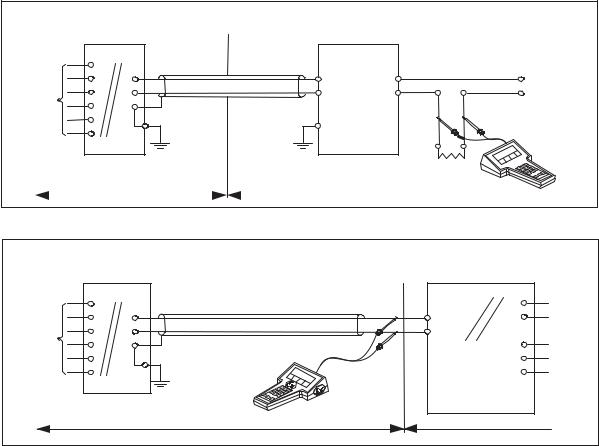
2-6 Specifications
2-4. Control Drawing SC202S mA HART® Specification (IECEx)
Intrinsically safe design
IECEx standard Ex ia IIC: T4 for ambient temp. < 55°C
T6 for ambient temp. < 40°C
Certificate nr. IECEx KEM 06.0053X
SC202S (Conductivity/Resistivity-transmitter)
+
_
G
SENSOR(S)
terminals 11-16 |
Functional |
Functional |
|
earth |
earth |
Ex ia or ib
Certified safety barrier or power with Rint=300 :
(HART compatible)
Uo = 31.5 Volt DC
Io = 100 mA
Load
Resistance
24 volts DC Nominal Supply Voltage.
+
_
Hazardous area |
Safe area |
Zone 0 or 1
Intrinsically safe design
IECEx standard Ex ia IIC: T4 for ambient temp. < 55°C
T6 for ambient temp.< 40°C
|
Certificate nr. IECEx KEM 06.0053X |
|
SC202S (Conductivity/Resistivity-transmitter) |
|
+ |
|
_ |
|
G |
SENSOR(S) |
Functional |
terminals 11-16 |
|
|
earth |
|
Hazardous area |
|
Zone 0 or 1 |
Ex ia or ib Certified Repeater
Power Supply (HART Compatible)
+ |
Output |
|
|
_ |
|
Uo = 31.5 Volt DC |
Supply |
Io = 100 mA |
|
Po = 1.2 Watt |
|
Safe area
Sensor(s) are of a passive type to be regarded as ‘simple apparatus’. |
|
|||
Electrical data of the SC202S. |
|
|
|
|
- Supply and output circuit (terminals + and -): |
= 100 mA. |
|||
Maximum input voltage Ui = 31.5 V. |
|
Maximum input current Ii |
||
Maximum input power Pi = 1.2 W. |
Ci |
= 22 nF. |
|
|
Effective internal capacitance |
|
|||
Effective internal inductance |
Li |
= 35 PH. |
|
|
- Sensor input circuit (terminals 11 through 16): |
|
|||
Maximum output voltage Uo = 14.4 V. Maximum output current Io = 13 mA. |
||||
Maximum allowed external capacitance |
Co = 59 nF (for SC202S-A), |
|||
Maximum allowed external inductance |
Co = 2.9 PF (for SC202S-N). |
|||
Lo = 200 mH (for SC202S-A), |
||||
|
|
|
Lo = 450 mH (for SC202S-N). |
|
Barriers and power supply specification must not exceed the maximum values as shown in the diagram above. These safety descriptions cover most of
the commonly used industry standard barriers, isolators and power supplies.
The Hand Held Communicator must be of a IECEx certified intrinsically safe type in case it is used on the intrinsically safe circuit in the hazardous area or of a IECEx certified non-incendive type in case it is used in the non-incendive circuit in the hazardous area.
IM 12D08B02-01E
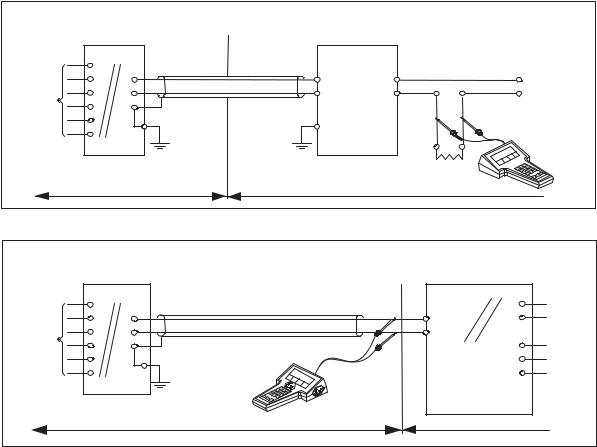
Specifications 2-7
2-5. Control Drawing SC202S mA HART® Specification (ATEX)
Intrinsically safe design |
|
|
CENELEC standard EEx ia IIC: T4 for ambient temp. < 55°C |
EEx ia or ib |
|
T6 for ambient temp. < 40°C |
Certified safety barrier or power |
|
Certificate nr. KEM A 06ATEX0220 X |
with Rint=300 : |
|
(HART compatible) |
||
SC202S (Conductivity/Resistivity-transmitter) |
||
|
|
+ |
|
|
|
_ |
|
Uo = 31.5 Volt DC |
|
G |
|
|
|
|
Io = 100 mA |
|
SENSOR(S) |
|
Functional |
|
terminals 11-16 |
Functional |
|
|
|
earth |
earth |
Load |
|
|
|
Resistance
24 volts DC Nominal Supply Voltage.
+
_
Hazardous area |
Safe area |
Zone 0 or 1
Intrinsically safe design
CENELEC standard EEx ia IIC: T4 for ambient temp. < 55°C
T6 for ambient temp.< 40°C
Certificate nr. KEM A 06ATEX0220 X
SC202S (Conductivity/Resistivity-transmitter)
+
_
G
SENSOR(S)
terminals 11-16 Functional earth
Hazardous area
Zone 0 or 1
EEx ia or ib Certified Repeater Power Supply
(HART Compatible)
+ |
Output |
|
|
_ |
|
Uo = 31.5 Volt DC |
Supply |
Io = 100 mA |
|
Po = 1.2 Watt |
|
Safe area
Sensor(s) are of a passive type to be regarded as ‘simple apparatus’.
Electrical data of the SC202S.
- Supply and output circuit (terminals + and -): |
= 100 mA. |
|||
Maximum input voltage Ui = 31.5 V. |
|
Maximum input current Ii |
||
Maximum input power Pi = 1.2 W. |
Ci |
= 22 nF. |
|
|
Effective internal capacitance |
|
|||
Effective internal inductance |
Li |
= 35 PH. |
|
|
- Sensor input circuit (terminals 11 through 16): |
|
|||
Maximum output voltage Uo = 14.4 V. Maximum output current Io = 13 mA. |
||||
Maximum allowed external capacitance |
Co = 59 nF (for SC202S-A), |
|||
Maximum allowed external inductance |
Co = 2.9 uF (for SC202S-N). |
|||
Lo = 200 mH (for SC202S-A), |
||||
|
|
|
Lo = 450 mH (for SC202S-N). |
|
Barriers and power supply specification must not exceed the maximum values as
shown in the diagram above. These safety descriptions cover most of the commonly used industry standard barriers, isolators and power supplies.
The Hand Held Communicator must be of a ATEX certified intrinsically safe type in case it is used on the intrinsically safe circuit in the hazardous area or of a ATEX certified non-incendive type in case it is used in the non-incendive circuit in the hazardous area.
IM 12D08B02-01E
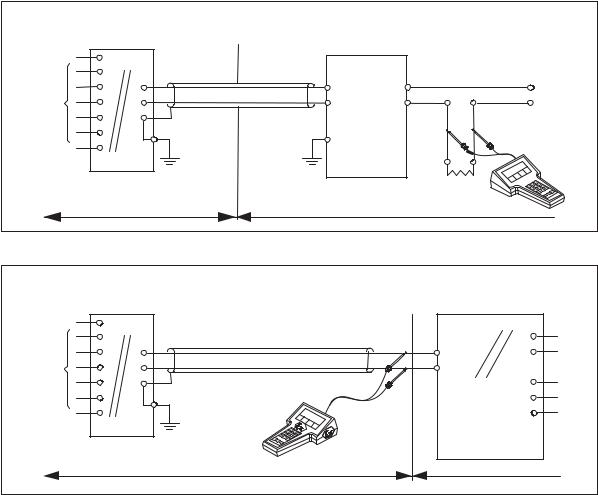
2-8 Specifications
2-6. Control Drawing SC202S mA HART® Specification (FM Intrinsically safe design).
Intrinsically safe design |
|
|
FM Approved safety barrier or |
||
FM Class I, Div.1, Group ABCD, |
T4 |
for ambient temp. < 55°C |
|||
power supply |
|
||||
|
T6 |
for ambient temp. < 40°C |
|
||
SC202S transmitter |
with Rint = 300 |
: |
|||
|
|
||||
|
|
(HART compatible) |
|||
|
|
|
|||
24 volts DC Nominal Supply Voltage.
|
+ |
|
|
+ |
|
|
|
|
|
|
_ |
|
|
- |
|
G |
|
|
|
|
|
|
|
|
Sensor |
For electrical data: |
|
|
|
terminals 11-16 |
see text below. |
Functional |
Functional |
|
Max. cablelength: 60 mtr. |
|
|
||
|
earth |
earth |
Load |
|
Cable dia. : 3…12 mm. |
|
|||
|
|
|
||
|
|
|
|
Resistance |
|
Classified Location |
Unclassified Location |
|
|
Figure 1
Intrinsically safe design |
|
|
|
FM Approved |
||
FM |
Class I, Div.1, Group ABCD, |
T4 |
for ambient temp. < 55°C |
|||
Power Supply |
||||||
|
|
|
T6 |
for ambient temp. < 40°C |
||
SC202S transmitter |
|
(HART compatible) |
||||
|
|
|
||||
|
|
|
|
|||
|
+ |
|
|
|
Output |
|
|
|
|
|
+ |
||
|
_ |
|
|
|
_ |
|
|
G |
|
|
|
|
|
|
|
|
|
|
Supply |
|
Sensor |
For electrical data: |
|
|
|
|
|
terminals 11-16 |
see text below. |
Functional |
|
|
|
|
|
|
|
|
|||
Max. cablelength: 60 mtr. |
earth |
|
|
|
||
Cable dia.: 3…12 mm. |
|
|
|
|
|
|
|
Classified Location |
|
|
Ùnclassified Location |
||
|
|
|
|
|
Figure 2 |
|
Electrical data of the SC202S.
- Supply circuit (terminals + and ):
Maximum input voltage Vmax = 31.5 V. Maximum input current Imax = 100 mA. Maximum input power Pmax = 1.2 W.
Effective internal capacitance Ci = 22 nF. |
Effective internal inductance Li = 35 PH. |
- Sensor input circuit (terminals 11 through 16) : |
|
Maximum output voltage Vt = 14.4 V. |
Maximum output current It = 10 mA. |
Maximum allowed external capacitance |
Ca = 59.36 nF. |
Maximum allowed external inductance |
La = 340 mH. |
If Hand Held Terminal (HHT) is not connected to the power supply lines of the SC202S
(see figure 1):
Any FM Approved barrier or power supply may be used that meets the following requirements. Voc or Vt d 31.5 V ; Isc or It d 100 mA; Ca t 22nF + Ccable ; La t 35PH + Lcable
If HHT is connected to the power supply lines of the SC202S (see figure 2):
The Hand Held Terminal must be FM Approved. Refer to the manufacturers control drawing of the HHT and the barrier/power supply to determine the cable parameters.
(Voc or Vt ) + VHHT d 31.5 V; (Isc or It ) + IHHT d 100 mA; Ca t 22nF + Ccable+ CHHT ; La t 35PH + Lcable+ LHHT
When installing this equipment, follow the manufacturer’s installation drawing.
Installation should be in accordance with ANSI/ISA RP 12.06.01 “Installation of Intrinsically Safe Systems for Hazardous (Classified) Locations” and the National Electrical Code (ANSI/NFPA 70). Control equipment connected to the barrier/power supply must not use or generate more than 250 Vrms or Vdc.
Resistance between Intrinsically Safe Ground and earth ground must be less than 1.0 Ohm.
In case of using cable glands in Outdoor location, they shall be UV rated or made of metal. WARNING
-Substitution of components may impair Intrinsic Safety
-To prevent ignition of flammable or combustible atmospheres, disconnect power before servicing or read, understand and adhere to the manufacturer’s’live maintenance procedures.
IM 12D08B02-01E |
Application Doc. No.: IKE026-A10 P.5 to P.6 |
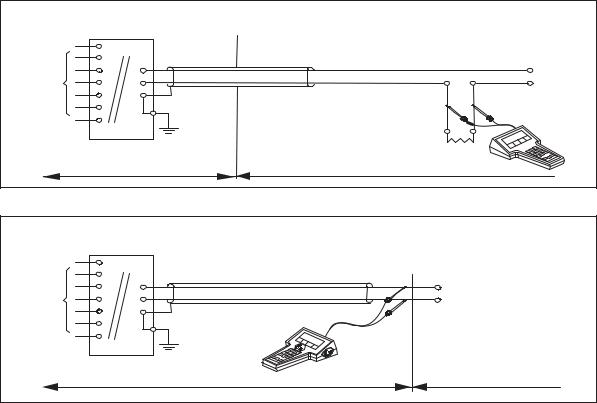
Specifications 2-9
2-7. Control Drawing SC202S mA HART® Specification (FM Non-incendive design)
N o nincendive design |
|
|
|
|
|
|
|
FM |
C lass I, D iv .2 , G roup A B C D , |
T 4 |
fo r a m bie nt tem p . < 55 °C |
|
|
||
S C 2 02 S tra nsm itter |
|
T 6 |
fo r a m bie nt tem p . < 40 °C |
FM |
A p pro ved |
||
|
|
|
|
||||
|
|
|
|
|
|
po w er sup ply |
|
|
|
|
|
|
|
V oc 31 .5 V D C |
|
|
+ |
|
|
|
|
|
+ |
|
|
|
|
|
|
|
|
|
_ |
|
|
|
|
|
- |
|
G |
|
|
|
|
|
|
|
|
|
|
|
|
|
|
S enso r |
Fo r electrical data: |
|
|
|
|
|
|
term inals 1 1 -1 6 |
see text belo w . |
Functional |
|
|
|
|
|
M ax. cab lelength: 6 0 m tr. |
|
|
|
|
|
||
C ab le dia . : 3 … 1 2 m m . |
|
earth |
|
|
|
L oad |
|
|
|
|
|
|
|
R esistance |
|
|
C lassified L oc atio n |
|
|
|
U nclassified Lo cation |
|
|
N onincend ive d esign |
|
|
|
|
|
|
|
F M |
C lass I, D iv .2 , G ro up A B C D , |
T 4 |
fo r am bient tem p . < 5 5°C |
|
|
||
S C 2 02 S transm itter |
|
T 6 |
fo r am bient tem p . < 4 0°C |
FM A p pro ved |
|
||
|
|
|
|
|
|||
|
|
|
|
po w er sup p ly |
|
||
|
|
|
|
|
|
|
|
|
|
|
|
|
|
V oc 3 1 .5 V D C |
|
|
+ |
|
|
|
|
+ |
|
|
|
|
|
|
|
|
|
|
_ |
|
|
|
|
- |
|
|
G |
|
|
|
|
|
|
|
|
|
|
|
|
|
|
S enso r |
Fo r electrical data: |
|
|
term inals 1 1 -1 6 |
see text belo w . |
Functio nal |
|
|
|
||
M ax. cab lelength: 6 0 m tr. |
|
||
e arth |
|
||
C ab le dia .: 3 … 12 m m |
|
|
|
|
|
|
|
|
C lassified L o catio n |
Ù nclassified Lo cation |
|
Electrical data of the SC202S. |
|
- Supply circuit (terminals + and -): |
Maximum input power Pmax = 1.2 W |
Maximum input voltage Vmax = 31.5 V. |
|
Effective internal capacitance Ci = 22 nF |
Effective internal inductance Li = 35 μH |
- Sensor input circuit (terminals 11 through 16): |
|
Maximum output voltage Vt = 14.4 V. |
Maximum output current It = 10 mA. |
Maximum allowed external capacitance |
Ca = 1.71 μF. |
Maximum allowed external inductance |
La = 600 mH. |
The Hand Held Terminal must be FM Approved in case it is used in the classified location. When installing this equipment, follow the manufacturers installation drawing. Installation shall be in accordance with Article 501.4(B) of the National Electrical Code. Non-incendive field wiring may be installed in accordance with Article 501 of the National Electrical Code.
Grounding shall be in accordance with Article 250 of the National Electrical code
In case of using cable glands in Outdoor location, they shall be UV rated or made of metal.
WARNING
- Substitution of components may impair suitability for Division 2
- Do not remove or replace while circuit is live unless area is know to be non-hazardous - Explosion Hazard – Do not disconnect equipment unless area is know to be
non-hazardous
-Do not reset circuit breaker unless power has been removed from the equipment or the area is know to be non-hazardous
Application Doc. No.: IKE026-A10 P.7 to P.8
IM 12D08B02-01E
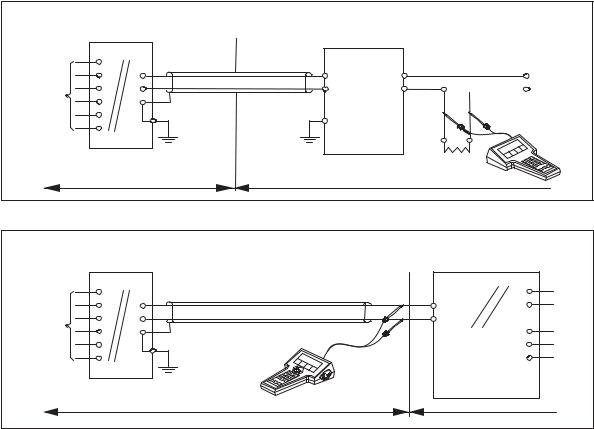
2-10 Specifications
2-8. Control Drawing of SC202S mA HART® Specification (CSA)
Intrinsically safe design |
|
CSA certified |
|
CSA Ex ia Class1, D iv.1, G roup ABCD , T4 |
for ambient temp. < 55°C |
||
safety barrier or pow er supply |
|||
T6 |
for ambient temp. < 40°C |
||
|
|
with Rint=300 : |
|
SC202S transmitter |
|
(HART compatible) |
|
|
|
|
+ |
|
|
Sensor |
_ |
|
|
G |
|
Suitable values are: |
|
term inals 11-16 |
|
Vmax = 31.5 VoltD C |
|
|
|
|
|
|
|
|
Imax = 100 mA |
|
For electrical data: |
|
|
|
see text below . |
Functional |
Functional |
|
|
||
|
|
earth |
earth |
|
Hazardous area |
|
Safe area |
24 volts D C Nominal Supply Voltage.
+
 _
_
Load
Resistance
Intrinsically safe design |
|
|
|
|
CSA |
Ex ia Class1, D iv.1, G roup ABCD , T4 |
for ambient temp. < 55°C |
CSA certified |
|
|
T6 |
for ambient temp. < 40°C |
|
|
|
Pow er Supply |
|
||
SC202S transmitter |
|
|
||
|
(HART compatible) |
|
||
|
|
|
|
|
|
+ |
|
+ |
O utput |
|
|
|
||
Sensor |
_ |
|
_ |
|
G |
|
Suitable values are: |
|
|
term inals 11-16 |
|
|
||
|
V max = 31.5 VoltDC |
Supply |
||
|
|
|
||
|
|
|
Imax = 100 mA |
|
|
|
|
Pmax = 1.2 W att |
|
For electrical data: |
|
|
|
|
see text below . |
|
|
|
|
|
Functional |
|
|
|
|
earth |
|
|
|
|
Hazardous area |
|
Safe area |
|
Sensor is a thermocouples, RTD’s, passive resistive switch devices, or is CSA entity approved and meet connection requirements.
Electrical data of the SC202S.
- Supply and output circuit (terminals + and -)
Maximum input voltage Vmax = 31.5 V. Maximum input current Imax = 100 mA. Maximum input power Pmax = 1.2 W.
Effective internal capacitance Ci = 22 nF. Effective internal inductance Li = 35 PH.
- Sensor input circuit (terminals 11 through 16):
Maximum output voltage Voc = 14.4 V. Maximum output current Isc = 13 mA. Maximum allowed external capacitance Ca = 59 nF.
Maximum allowed external inductance La = 200 mH.
Barriers and power supply should be CSA certified. The specifications must not exceed
the maximum values as shown in the diagram above. Installation should be in accordance with Canadian Electrical Code, Part I.
Maximum safe area voltage should not exceed 250 VRMS.
For Class I, Div. 2, Group ABCD the CSA certified barrier is not required, and the Sensor input circuit (terminals 11 through 16) is non-incendive having the parameters :
Maximum output voltage Voc = 14.4 V. Maximum output current Isc = 13 mA. Maximum allowed external capacitance Ca = 2.9 PF.
Maximum allowed external inductance La = 450 mH.
The Hand Held Communicator must be of a CSA certified intrinsically safe type in case it is used on the intrinsically safe circuit in the hazardous area, or of a CSA certified non-incendive type in case it is used on the non-incendive circuit in the hazardous area.
IM 12D08B02-01E
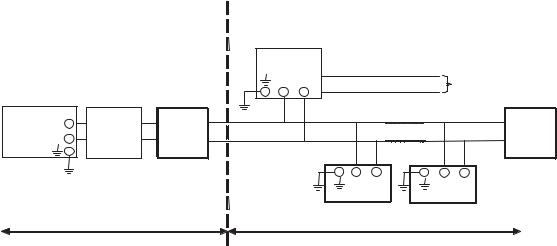
Specifications 2-11
2-9. Control Drawing of SC202S FF/PB Specification (IECEx)
Safe area |
+ |
I.S. |
Apparatus |
- |
interface |
Ex ia IIC
T4 for ambient temp. d 55 qC
Ui = 24 V |
or Ui = 17,5 V |
Ii = 250 mA |
Ii = 380 mA |
Pi = 1,2 W |
Pi = 5,32 W |
SC202S-F or SC202S-P
+-
I.S. certified Terminator
+ -
Sensor
Connections
I.S. certified Terminator
+-
Transmitter Transmitter
Safe area |
Zone 0 or 1 |
|
Hazardous area |
|
xSensor(s) are of a passive type to be regarded as 'simple apparatus'.
xElectrical data of the SC202S-F & SC202S-P:
-Supply and output circuit: Maximum input voltage Ui= 24 V Maximum input current Ii= 250 mA Maximum input power Pi= 1.2 W
Effective internal capacitance Ci= 220 pF;
Effective internal inductance Li= 0 μH.
or
FISCO field device
Maximum input voltage Ui= 17.5 V Maximum input current Ii= 380 mA Maximum input power Pi= 5.32 W Effective internal capacitance Ci= 220 pF; Effective internal inductance Li= 0 μH.
-Sensor input circuit:
Maximum output voltage Uo= 14.4 V; Maximum output current Io= 13 mA Maximum allowed external capacitance Co= 59 nF
Maximum allowed external inductance Lo= 200 mH
x Any I.S. interface may be used that meets the following requirements:
Uo d 24 V |
|
Io d 250 mA |
|
Po d 1.2 W |
|
Ca t 220 pF + Ccable; |
La t 0 μH + Lcable |
or |
|
FISCO power supply |
|
Uo d 17.5 V |
|
Io d 380 mA |
|
Po d 5.32 W |
|
Ca t 220 pF + Ccable; |
La t 0 μH + Lcable |
xElectrical data of the SC202S-B & SC202S-D (Type of protection “n”)
-Supply and output circuit: Maximum input voltage Ui = 32 V
Effective internal capacitance Ci = 220 pF; Effective internal inductance Li = 0 μH.
-Sensor input circuit:
Maximum output voltage Uo= 14.4 V; Maximum output current Io= 13 mA Maximum allowed external capacitance Co = 2.9 μF
Maximum allowed external inductance Lo = 450 mH
IM 12D08B02-01E

2-12 Specifications
2-10. Control Drawing of SC202S FF/PB Specification (ATEX)
Safe area |
+ |
I.S. |
Apparatus |
- |
interface |
Ex ia IIC
T4 for ambient temp. d 55 qC
Ui = 24 V |
or Ui = 17,5 V |
Ii = 250 mA |
Ii = 380 mA |
Pi = 1,2 W |
Pi = 5,32 W |
SC202S-F or SC202S-P
+-
I.S. certified Terminator
+ -
Sensor
Connections
I.S. certified Terminator
+-
Transmitter Transmitter
Safe area |
Zone 0 or 1 |
|
Hazardous area |
|
xSensor(s) are of a passive type to be regarded as 'simple apparatus'.
xElectrical data of the SC202S-F & SC202S-P:
- Supply and output circuit: Maximum input voltage Ui= 24 V Maximum input current Ii= 250 mA Maximum input power Pi= 1.2 W
Effective internal capacitance Ci= 220 pF; Effective internal inductance Li= 0 μH.
or
FISCO field device
Maximum input voltage Ui= 17.5 V Maximum input current Ii= 380 mA Maximum input power Pi= 5.32 W Effective internal capacitance Ci= 220 pF; Effective internal inductance Li= 0 μH.
- Sensor input circuit:
Maximum output voltage Uo= 14.4 V; Maximum output current Io= 13 mA Maximum allowed external capacitance Co= 59 nF
Maximum allowed external inductance Lo= 200 mH
x Any I.S. interface may be used that meets the following requirements: Uo d 24 V
Io d 250 mA
Po d 1.2 W
Ca t 220 pF + Ccable; La t 0 μH + Lcable
or
FISCO power supply Uo d 17.5 V
Io d 380 mA
Po d 5.32 W
Ca t 220 pF + Ccable; La t 0 μH + Lcable
xElectrical data of the SC202S-B & SC202S-D (Type of protection “n”)
-Supply and output circuit: Maximum input voltage Ui = 32 V
Effective internal capacitance Ci= 220 pF; Effective internal inductance Li= 0 μH.
-Sensor input circuit:
Maximum output voltage Uo=14.4V; Maximum output current Io= 13 mA Maximum allowed external capacitance Co = 2.9 μF
Maximum allowed external inductance Lo = 450 mH
IM 12D08B02-01E

Specifications 2-13
2-11. Control Drawing of SC202S FF/PB Specification (FM Intrinsically safe Entity)
|
|
|
FM Class I, DIV. 1, Group ABCD |
|
|
|
T4 for ambient temp. d 55 qC |
|
|
|
SC202S-F |
|
|
|
or SC202S-P |
|
|
+ - |
|
FM Approved |
|
||
|
|
|
|
barrier |
|
|
|
Ioc (It) d 250 mA |
+ |
|
I.S. |
Voc (Vt) d 24 V |
|
|
certified |
Poc (Pt) d 1.2 W |
- |
|
|
|
Terminator |
||
Ca t 220pF+ Ccable |
|
||
La t 0 H + Lcable |
|
|
|
+ -
Transmitter
Sensor Connections
Max. cablelength: 60 mtr. Cable dia. : 3…12 mm.
Sensor
Connections
I.S. certified Terminator
+-
Transmitter
Unclassified Location |
Division 1 |
Classified Location |
xSensor(s) are of a passive type to be regarded as 'simple apparatus', devices which neither store nor generate voltages over 1.5 V, currents over 0.1 A, power over 25 mW or energy over 20 PJ, or are FM Approvals entity approved and meet connection requirements.
xElectrical data of the SC202S-F & SC202S-P:
-Supply circuit:
Maximum input voltage Vmax= 24 V Maximum input current Imax= 250 mA Maximum input power Pi= 1.2 W
Effective internal capacitance Ci = 220 pF; Effective internal inductance Li = 0 PH.
-Sensor input circuit:
Maximum output voltage Vt= 14.4 V; Maximum output current It= 10 mA Maximum allowed external capacitance Ca= 59.36 nF
Maximum allowed external inductance La= 340 mH
xAny FM Approved barrier may be used that meets the following requirements: Voc or Vt d 24 V
Ioc or It d 250 mA Poc or Pt d 1.2 W
Ca t 220 pF + Ccable; La t 0 PH + Lcable
When installing this equipment, follow the manufacturer’s installation drawing. Installation should be in accordance with ANSI/ISA RP 12.06.01 “Installation of Intrinsically Safe Systems for Hazardous (Classified) Locations” and the National Electrical Code (ANSI/NFPA 70).
Associated apparatus connected to the barrier must not use or generate more than 250 Vrms or Vdc.
xResistance between Intrinsically Safe Ground and earth ground must be less than 1.0 Ohm.
xIn case of using cable glands in Outdoor location, they shall be UV rated or made of metal. WARNING
-Substitution of components may impair Intrinsic Safety
-To prevent ignition of flammable or combustible atmospheres, disconnect power before servicing or read, understand and adhere to the manufacturer’s live maintenance procedures.
IM 12D08B02-01E
2-14 Specifications
xThe cable used to interconnect the devices needs to comply with the following parameters:
Loop resistance R’: 15 … 150 Ω/km; Inductance per unit length L’: 0,4 … 1 mH/km Capacitance per unit length C’: 80 … 200 nF/km
(C’ = C’ line/line + 0,5 C’ line/screen if both line are floating)
(C’ = C’ line/line + C’ line/screen if the screen is connected to one line) Length of spur cable: max. 30 m
Length of trunk cable: max. 1 km Length of splice : max. 1 m
WARNING
-Substitution of components may impair Intrinsic Safety
-To prevent ignition of flammable or combustible atmospheres, disconnect power before servicing or read, understand and adhere to the manufacturer’s live maintenance procedures.
Application Doc. No.: IKE027-A10 P.5 to P.6
IM 12D08B02-01E
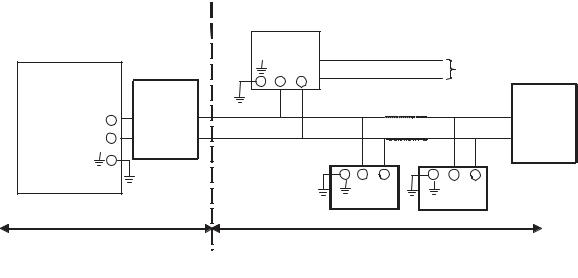
Specifications 2-15
2-12. Control Drawing of SC202S FF/PB Specification (FM Intrinsically safe FISCO)
FM Approved
FISCO barrier
|
|
FM Approved |
Voc (Vt) d17,5 V |
+ |
Terminator |
Ioc (It) d380 mA |
R = 90..100Ω |
|
Poc (Pt) d5,32 W |
- |
C = 0..2,2 μF |
Unclassified Location
FM Class I, DIV. 1, Group ABCD T4 for ambient temp. d 55 qC
SC202S-F or SC202S-P
+-
Sensor
Connections
Max. cablelength: 60 mtr.
Cable dia. : 3…12 mm.
Sensor
Connections
FM Approved
Terminator
R = 90..100Ω
C = 0..2,2 μF
+ - |
+ - |
Transmitter Transmitter
Division 1
Classified Location
xSensor(s) are of a passive type to be regarded as 'simple apparatus', devices which neither store nor generate voltages over 1.5 V, currents over 0.1 A, power over 25 mW or energy over 20 PJ, or are FM Approvals entity approved and meet connection requirements.
xElectrical data of the SC202S-F & SC202S-P:
-Supply circuit: Vmax = 17.5 V; Imax = 380 mA; Pi = 5.32 W; Ci = 220 pF; Li = 0 PH.
-Sensor input circuit: Vt = 14.4 V; It = 10 mA; Ca = 59.36 nF; La = 340 mH
xAny FM Approved FISCO barrier may be used that meets the following requirements:
Voc or Vt d 17.5 V; Ioc or It d 380 mA; Poc or Pt d 5.32 W
When installing this equipment, follow the manufacturer’s installation drawing. Installation should be in accordance with ANSI/ISA RP 12.06.01 “Installation of Intrinsically Safe Systems for Hazardous (Classified) Locations” and the National Electrical Code (ANSI/NFPA 70).
Associated apparatus connected to the FISCO barrier must not use or generate more than 250 Vrms or Vdc.
xResistance between FISCO Intrinsically Safe Ground and earth ground must be less than 1.0 Ohm.
xIn case of using cable glands in Outdoor location, they shall be UV rated or made of metal.
xThe FISCO concept allows the interconnection of several I.S. apparatus not specifically examined in such combination. The criterion for such interconnection is that the voltage (Vmax), the current (Imax) and the power (Pi) which I.S. apparatus can receive and remain intrinsically safe, considering faults, must be equal to or greater that the voltage (Voc, Vt), the current (Ioc, It) and the power (Poc, Pt) which can be providede by the FM approved FISCO barrier. In addition, the maximum unprotected residual capacitance (Ci) and inductance (Li) of each apparatus (other than the terminator) connected to the Fieldbus must be less than or equal to 5nF and 10 μH respectively.
IM 12D08B02-01E
2-16 Specifications
xIn each I.S. Fieldbus segment only one active source, normally the FM Approved FISCO barrier, is allowed to provide the necessary power for the Fieldbus system. All other equipment connected to the bus cable has to be passive (not providing energy to the system), except to a leakage current of 50μA for each connected device. Seperately powered equipment needs a galvanic isolation to insure that the I.S. Fieldbus circuit remains passive.
xThe cable used to interconnect the devices needs to comply with the following parameters:
Loop resistance R’: 15 … 150 Ω/km; Inductance per unit length L’: 0,4 … 1 mH/km Capacitance per unit length C’: 80 … 200 nF/km
(C’ = C’ line/line + 0,5 C’ line/screen if both line are floating)
(C’ = C’ line/line + C’ line/screen if the screen is connected to one line) Length of spur cable: max. 30 m
Length of trunk cable: max. 1 km Length of splice : max. 1 m
WARNING
-Substitution of components may impair Intrinsic Safety
-To prevent ignition of flammable or combustible atmospheres, disconnect power before servicing or read, understand and adhere to the manufacturer’s live maintenance procedures.
Application Doc. No.: IKE027-A10 P.7 to P.8
IM 12D08B02-01E
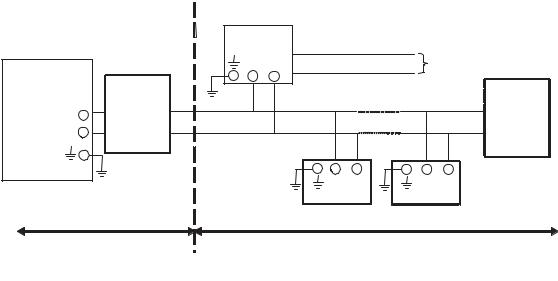
Specifications 2-17
2-13. Control Drawing of SC202S FF/PB Specification (FM Non-incendive Entity)
FM Approved
Power Supply
Voc d 32 VDC
+
-
FM Approved
Terminator
R = 90..100Ω
C = 0..2,2 μF
FM Class I, DIV. 2, Group ABCD T4 for ambient temp. d 55 qC T6 for ambient temp. d 40 qC
SC202S-B or SC202S-D
+-
+ -
Sensor Connections
Max. cablelength: 60 mtr. Cable dia.: 3…12 mm.
Sensor
Connections
FM Approved
Terminator
R = 90..100Ω
C = 0..2,2 μF
+-
Transmitter Transmitter
|
Division 2 |
Unclassified Location |
Classified Location |
xSensor(s) are of a passive type to be regarded as 'simple apparatus', devices which neither store nor generate voltages over 1.5 V, currents over 0.1 A, power over 25 mW or energy over 20 μJ, or are FM Approvals entity approved and meet connection requirements.
xElectrical data of the SC202S-B & SC202S-D:
-Supply circuit: Vmax= 32 V; Pi= 1.2 W; Ci= 220 pF; Li= 0 PH
-Sensor input circuit: Vt= 14.4 V; It= 10 mA; Ca= 1.71 μF; La= 600 mH
When installing this equipment, follow the manufacturers installation drawing. Installation shall be in accordance with Article 501.4(B) of the National Electrical Code (ANSI/NFPA 79). Nonincendive field wiring may be installed in accordance with Article 501.4(B)(3)
xGrounding shall be in accordance with Article 250 of the National Electrical code.
xIn case of using cable glands in Outdoor location, they shall be UV rated or made of metal.
WARNING
-Substitution of components may impair suitability for Division 2.
-Do not remove or replace while circuit is live unless area is know to be non-hazardous
-Explosion Hazard – Do not disconnect equipment unless area is know to be non-hazardous
-Do not reset circuit breaker unless power has been removed from the equipment or the area is know to be non-hazardous
Application Doc. No.: IKE027-A10 P.9
IM 12D08B02-01E
